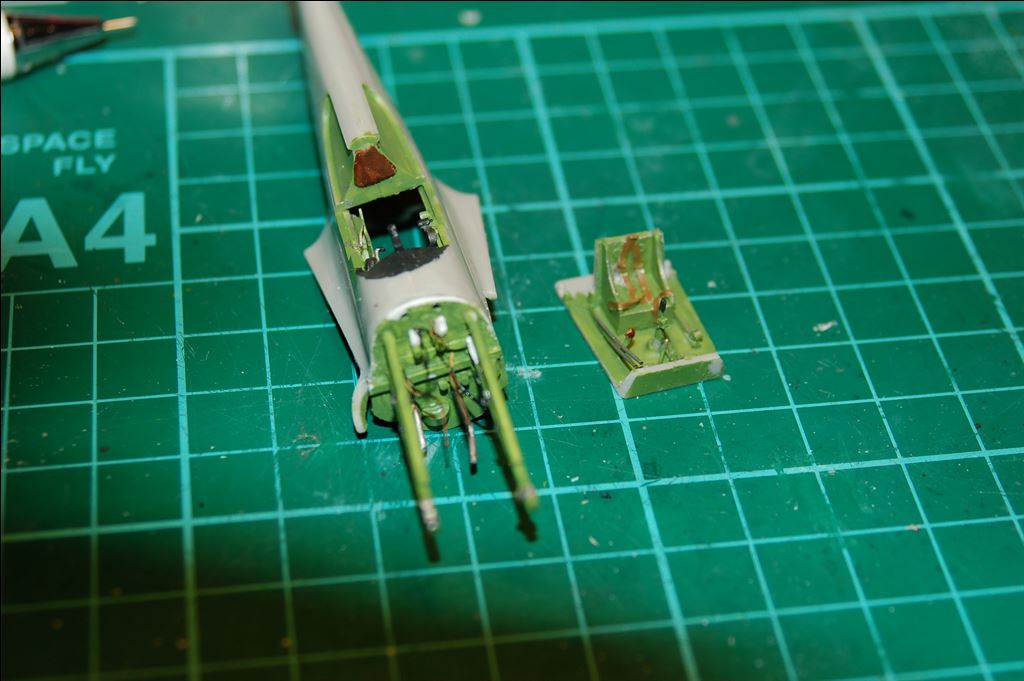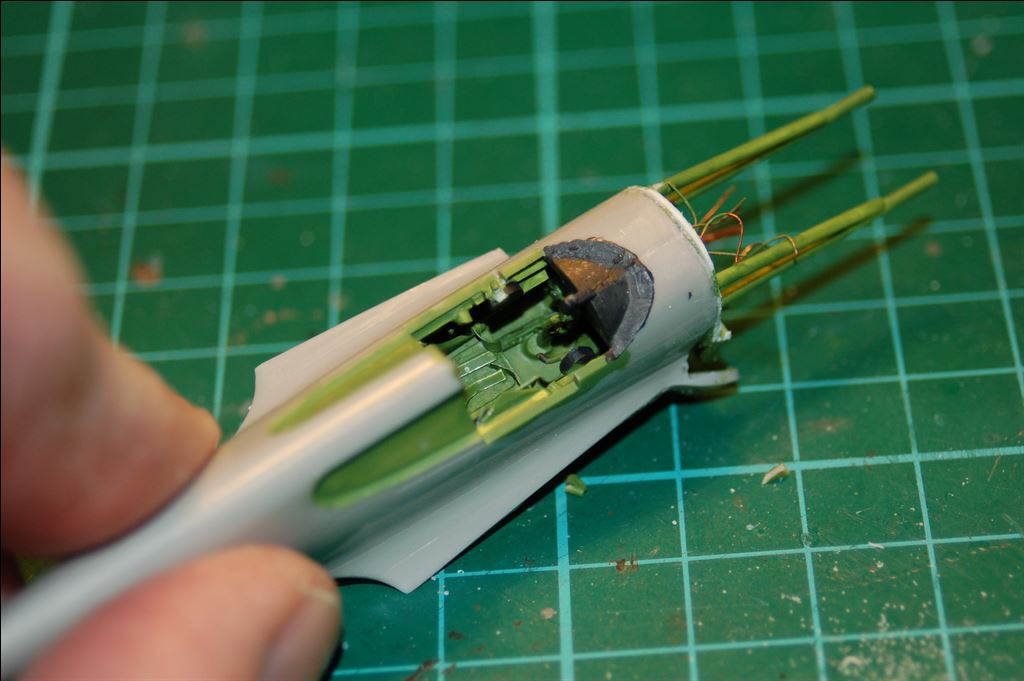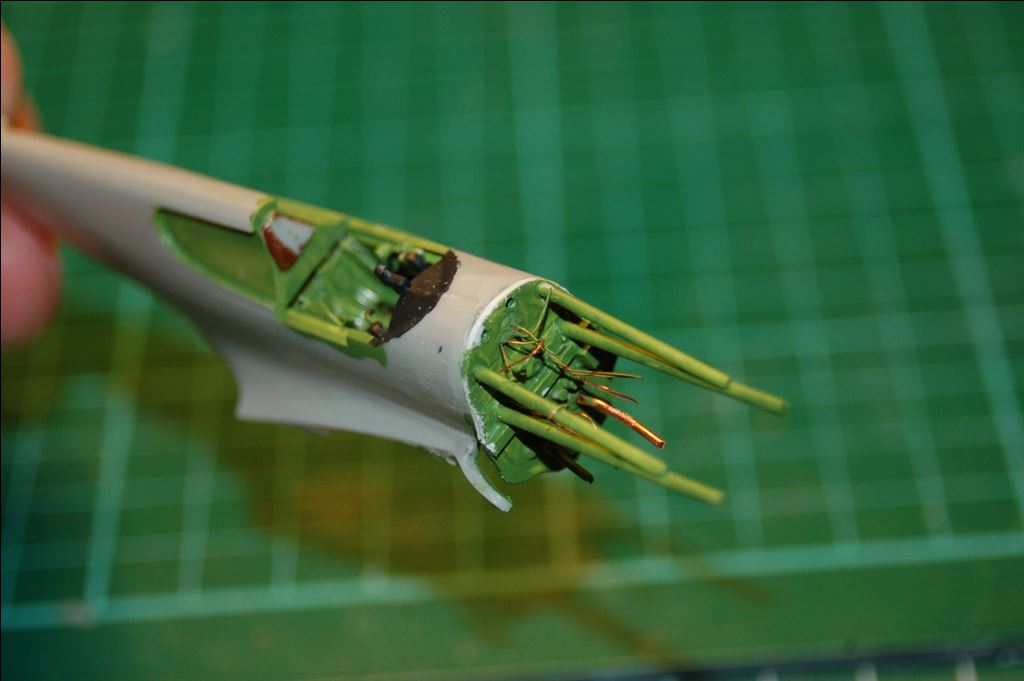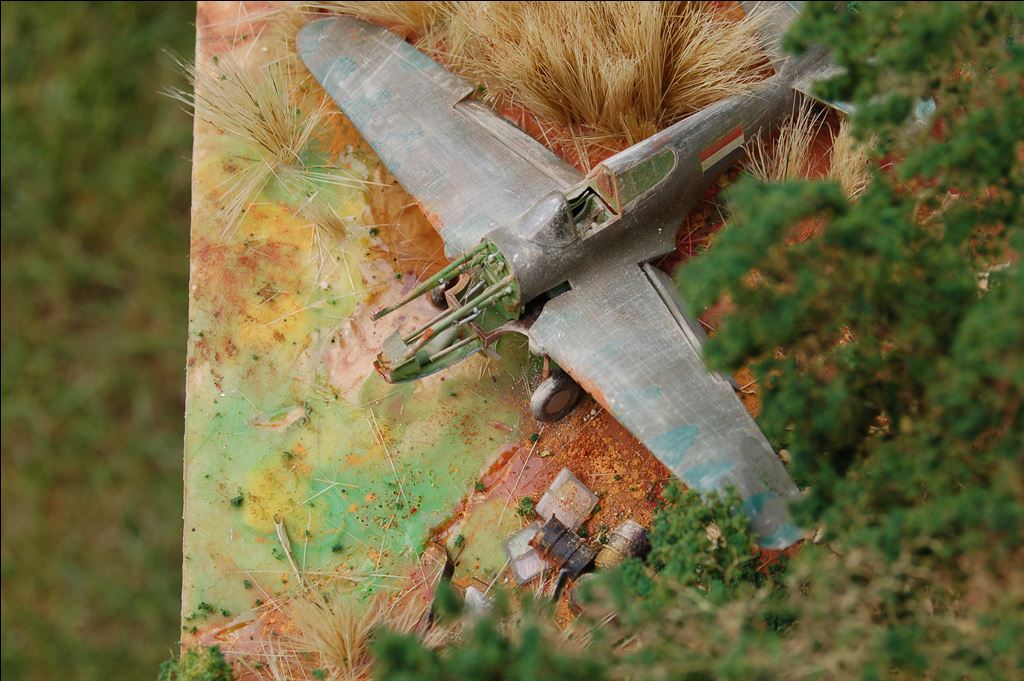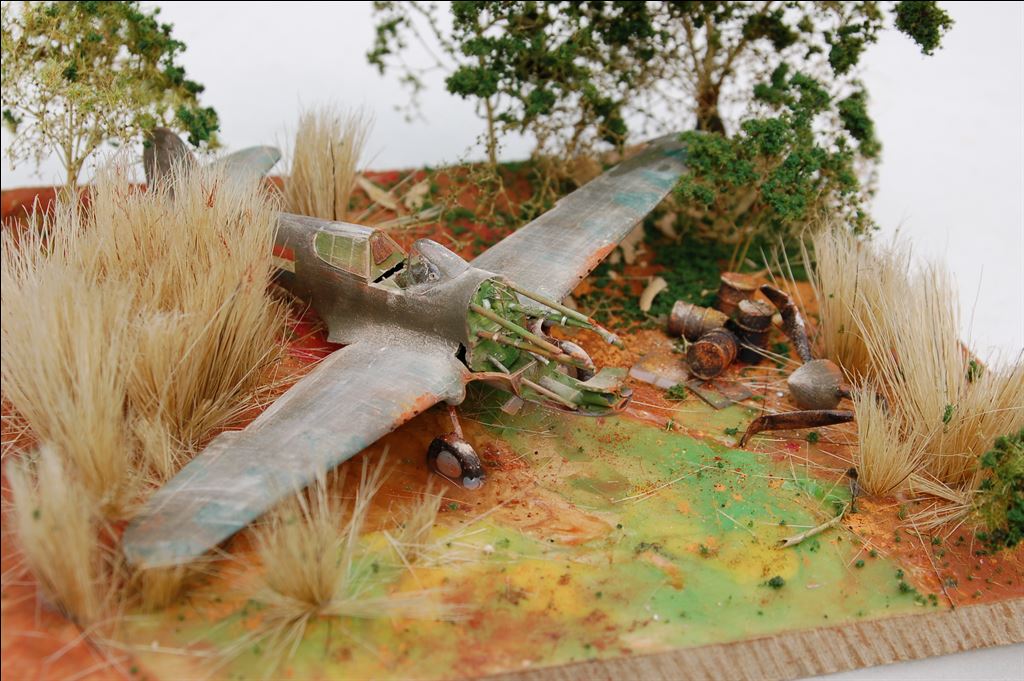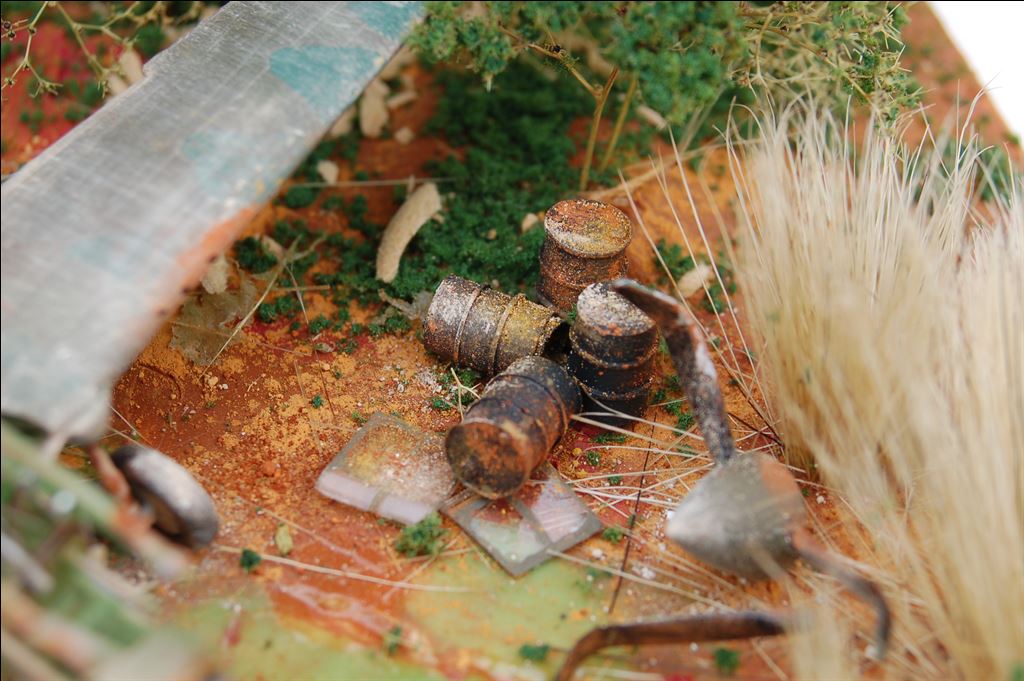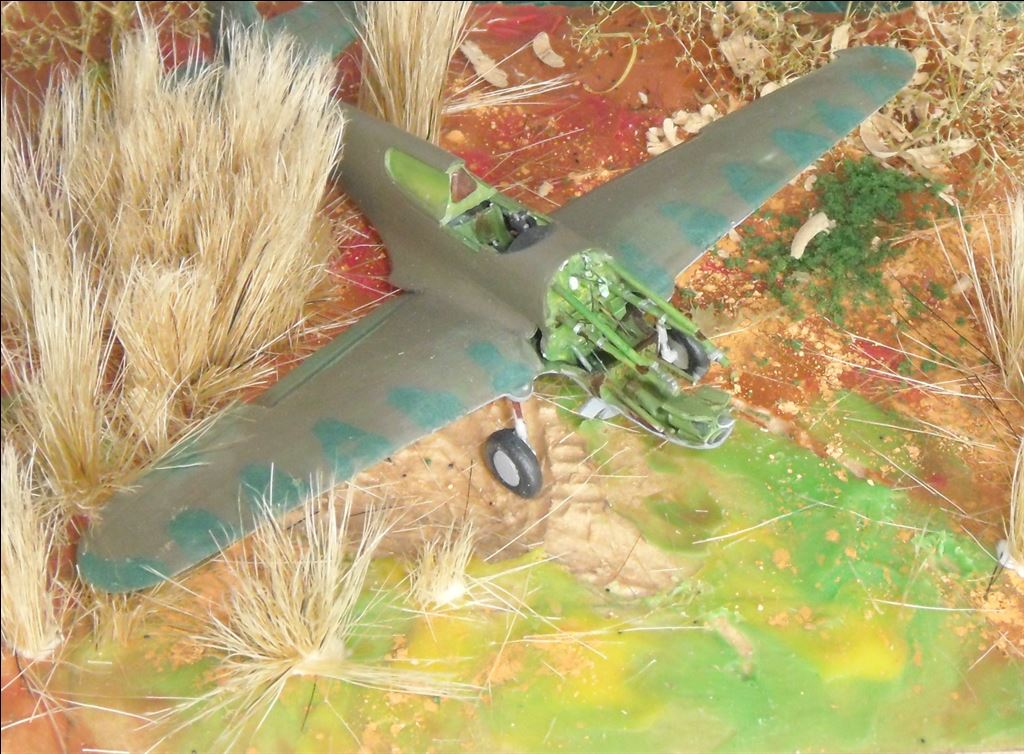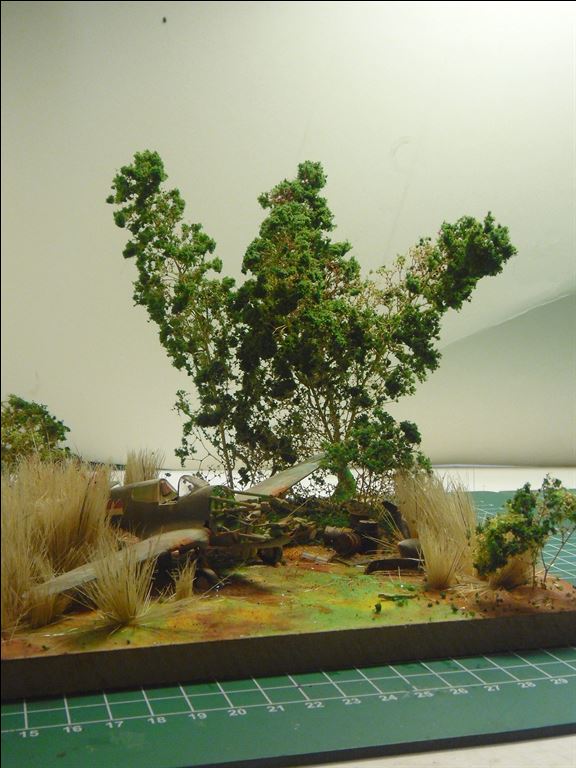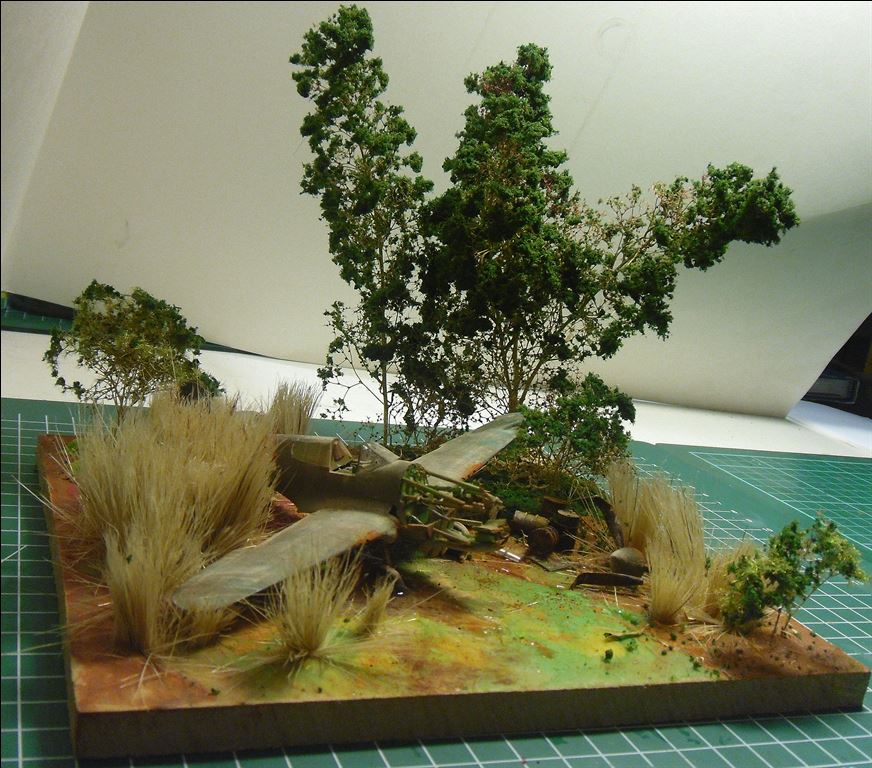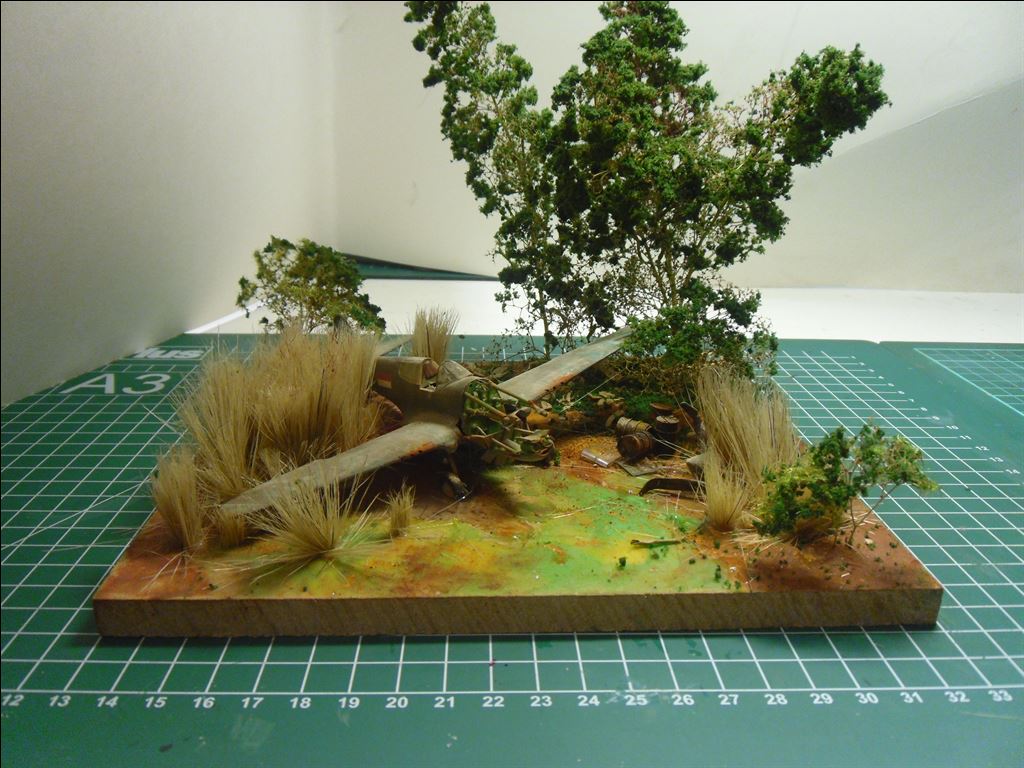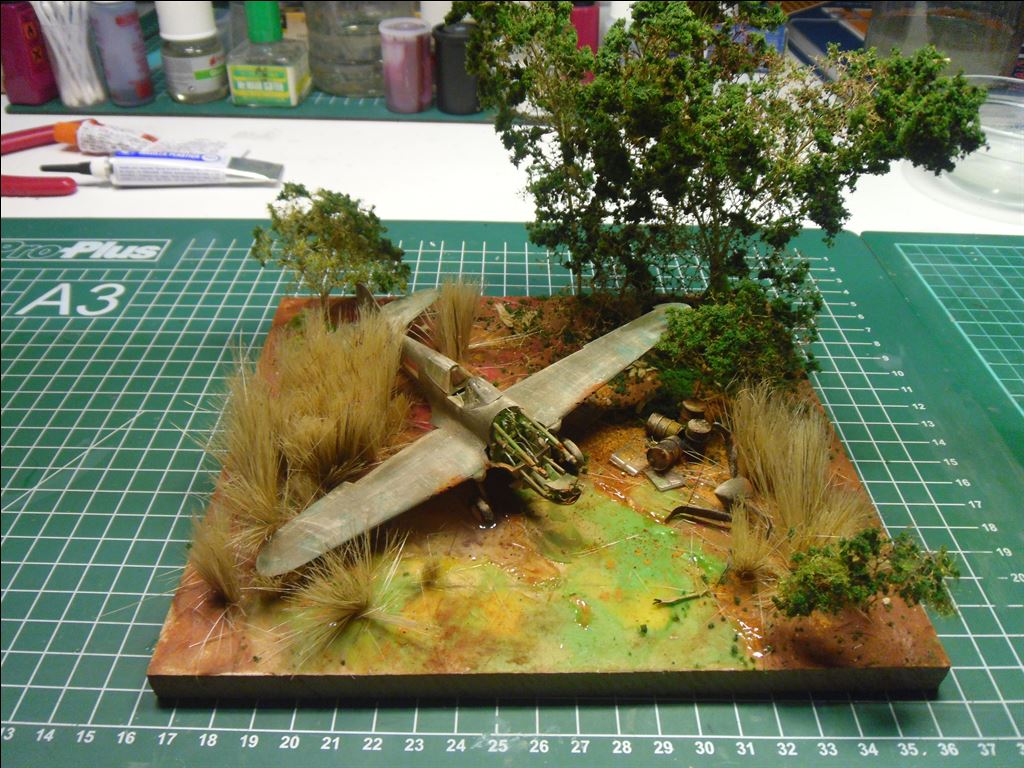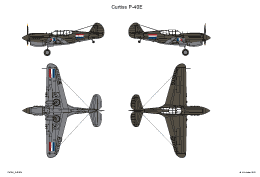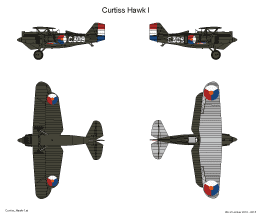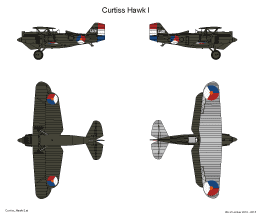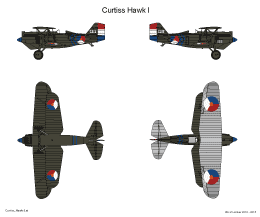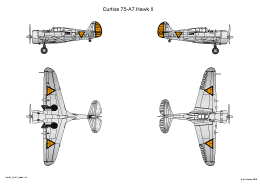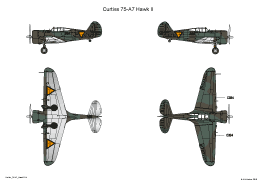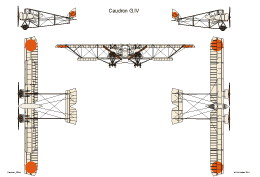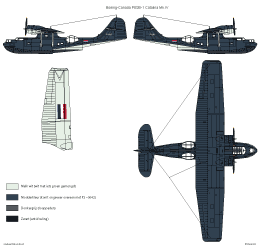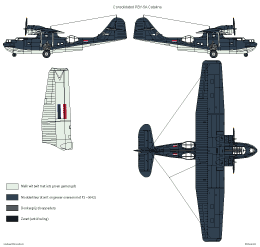- Details
- Hits: 32785
History
A constructor, D.R. Berlin, originating from Northrop was assigned by Curtiss to the Curtis H-75 project. This project was based upon USAAC specifications.
In the end Seversky won the contract, but Curtiss produced three aircraft as YP-36. In June 1937 an order for 200 aircraft followed and also France ordered 200 examples of the Curtiss P-36. Several other countries also ordered the Curtiss Hawk II, as did the Dutch East Indies Government.
The design was used to develop an aircraft which was faster than 300 mph and equipped with the Allison turbo compressed line engine and a redesigned fuselage.
The USAAC ordered an exampled for testing purposes under the designation XP-37. The aircraft looked very fast and had the looks of a racing aircraft rather than a fighter, especial because of the large Allison V1710 engine. The maximum speed of the XP-37 was 340 mph.
The long nose obstructed the view forward seriously, especially because of the turbocharger which took a lot of space.
Berlin proposed adjusting the P-36A fuselage with an adjusted Allison V1710 engine rated 1050 hp. The expected performance of this new design resulted in an order of the USAAC for one XP-40.
The XP-40 was successful, though the performance was somewhat disappointing. Further aerodynamic refinements and a stronger Allison V1710-35 engine improved the performance in such a way resulted in in pre-orders for the Curtiss P-40.
Versions.
- Curtiss XP-40:
- Curtiss 75P: the prototype of the P-40; a fuselage of a P-36A equipped with the new Allison V-1710-19 engine. Made its first flight in October 1938.
- Curtiss P-40:
- First production version, Curtiss model 81A-1. Circa 200 examples built for the USAAC. No self sealing fuel tanks and armour; two machine guns in the nose plus two in the wings; circa 140 examples were assigned to France,but this series was completely taken over by the British after the invasion of France and, equipped with British armament ().303 inch machine guns) used by the RAF under the designation Tomahawk I.
- Curtiss P-40A:
- a P-40, equipped with a camera in the aft fuselage.
- Curtiss P-40B:
- Curtiss H-81A-2; 110 examples for the RAF designated Tomahawk IIA; equipped with four machine guns in de wings; armor and self sealing fuel tanks. The USAAC ordered 131 examples, (Curtiss H81-B).
- Curtiss >P-40C:
- 930 examples for the RAF designated as Tomahawk IIB; as P-40B plus provision for droptank of bomb under the fuselage; self sealing fuel tanks. The USAAC received 193 examples.
- Curtiss P-40D:
- Equipped with a new, more powerful Allison V-171039 engine; revised fuselage; new designed canopy and cockpit; armament in the nose was moved to the wing; RAF ordered 50 examples as Kittyhawk I (Curtiss H-87); the USAAC ordered 23 examples designated as P-40D (Curtiss 87-A2)
- Curtiss P-40E:
- Virtual identical to the P-40D, but with six machine guns in the wing. The Raf received 1500 examples as Kittyhawk IA (Curtis 87-A3 and A4); the USAF ordered 820 examples (Curtiss 87-B2) designated as P-40E-1.
- Curtiss P-40F:
- This version was equipped with a Packard built Merlin V-1650-1 rated 1300 hp (in the start and 1120 hp at 18500 feet). The nose section was revised; The first 699 aircraft had the same fuselage as the P-40E; The RAF received an unknown number as Kittyhawk II.
- P-40F-5 : because of problems with the stability the tail section was lengthened with 20 inch. 122 examples built. [USAAF serials: 41-14300 - 41-14422]
- P-40F-10: manual adjustment of colling was replaced by an elecrtonically adjusted system; 177 examples built [USAAF serials: 41-14423- - 41-14599]
- P-40F-15: 200 examples with modifications for use in Alaska [USAAF serials:41-19733 - 41-19932]
- P-40F-20: 112 examples with an adjustable oxygen provision. [USAAF serials: 41-19933 - 41-20044]
- Curtiss P-40G:
- 43 P-40s equipped with the wing of the Tomahawk Mk IIA, with four machine guns. 16 examples went to the Soviet Union; the remaining example to the USAAF.
- Curtiss P-40K:
- 1300 examples with a mor powerful Allison V-1710-73 engine rated 1350 hp at take off. The first 800 aircraft (block 1 and block 5) had the same fuselage as the P-40E; later production version had an enlarged tail fin to improve stability. About 192 examples went to the RAF as Kittyhawk III.
- Curtiss P-40L:
- A slimmed version of the P-40F to improve the performance. Factory designation Curtiss model H-87B-3. 700 examples built, of which 100 examples went to the RAF as Kittyhawk II.
- Curtiss P-40M:
- Further development of the P-40K with a Allison V-1710 F20R rated 1200 hp at take-off. Further a perforated panel was added to improve the cowling of the engine. 600 examples built, 94 examples went to the RAF, as Kittyhawk II.
- Curtiss P-40N:
- Last production version, Curtis model H87V en 87W, over 5500 examples built.
- P-40N-1: equipped with a Allison V-1710-81 engine and weight saving measures; 122 gallon internal fuel ; four .50 machine guns in the wing. About 400 examples built. [USAF serials: 42-104429 - 42-104828]
- P-40N-5 : circa 1100 examples built; revised canopy; frame-less wind screen; six .50 machine guns in the wing; provision for bombs under the wing . [USAF serials: 42-104829 - 42-105928.]
- P-40N-10: provisions for use in cold areas; four machine guns in the wing; about 100 examples built [USAF serials: 42-105929 - 42-106028.]
- P-40N-15: about 375 examples with battery repositioned; six machine guns in the wing and enlarged internal fuel capacity. [USAF serials: 42-106029 - 42-106405]
- P-40N-20: Over 200 examples with an Allison V-1710-99 engine (in fact a V-1710-81 with automatic engine control. [USAF serials: 42-106406 - 42-106428 en 43-22752 - 43-24251 ]
- P-40N-25: 500 examples as P-40N-20 with a revised instrument panel and non-metal self-sealing fuel tanks. [USAF-serials: 43-24252 - 43-24751]
- P-40N-30: Identical to P-40N-25, but with renewed electronic equipment and flaps. [USAF-serials: 44-7001 - 44-7500]
- P-40N-35: Version with revised carburettor, instruments such as radio and ADF equipment and lights. [USAF serials: 44-7501 - 44-8000]
- P-40N-40: Last version of the P-40; equipped with an Allison V-1710--115 engine rated 1300 hp. Further metal ailerons; improved self sealing fuel tanks; new radio an oxygen equipment and flame dampening exhausts . [USAF serials: 44-47749 - 44-47968 ]
| Dimensions: | |||
| Length: | 9,66 m | Wing span | 11,38 m |
| Height: | 3,76 m | Wing area: | 21,92 m2 |
| Weights: | |||
| Empty weight: | 2880 kg | Max. start weight: | 4000 kg |
| Performance: | |||
| Max. speed: | 580 km/hr | Cruising speed: | 435 km/hr |
| Range: | 1100 km | Service ceiling: | 8800 m |
| Miscellaneous: | |||
| Engine type: | One Allison V-1710-39 rated 1150 hp | ||
| Crew: | One pilot | ||
| Armament: | Six .50 inch machine guns plus 680 kg bombs. | ||
| Dimensions: | |||
| Length: | 10,2 m | Wing span | 11,42 m |
| Height: | 3,76 m | Wing area: | 21,95 m2 |
| Weights: | |||
| Empty weight: | 2724 kg | Max. start weight: | 4018 kg |
| Performance: | |||
| Max. speed: | 609 km/hr | Cruising speed: | - km/u |
| Range: | 3060 km (with extra tanks) | Service ceiling: | 11 630 m |
| Miscellaneous: | |||
| Engine type: | One Allison V-1710-82 rated 1200 hp | ||
| Crew: | One pilot | ||
| Armament: | Six .50 inch machine guns plus 680 kg bombs. | ||
Curtiss P-40E Warhawk
The Dutch Government was looking urgently for fighter aircraft to strengthen the NEIAF. Attempted was to buy Curtiss P-40 Warhawks. This was not possible because the US itself needed these aircraft urgently.Finally the Government managed to order 100 Hurricanes, which were not delivered in time. See the story about the NEIAF-Hurricanes.
During the Japanese attacks in Dutch East Indies a series of USAAF P-40E's were assigned to the NEIAF. Originally these Warhawks were meant to defend the British area in South-East Asia. Due to the speed of the Japanese attack, they were sent to Java, Dutch East Indies: 32 P-40E's on board of the aircraft tender Langley and 27 crated aircraft on board of freighter Seawitch. Both ships left Perth in Australia on February 22, 1942.
Threatened transport.
Japan conquered February 20, 1942 the isle of Bali and has landed on Timor. This was a thread to cut off the lines between Australia and Java. The islands were used for stops by the ferry flights of P-40's of the USAAC [several were lost because of the air attack on Bali and also because the US pilots could not find the air field Denpassar].
A limited number of US P-40E's was based on the eastern part of Java from early February 1942 and countered air fights over Ngoro and Soerabaja.
February 27 both transport ships approached the south coast of Java and were attacked. The Langley was lost. The same day the battle of the Java sea was fought.
Inconspicuous end.
The Seawitch arrived February 28, 1942 at Tjilatjap. Fifteen P-40E's were directed to the technical services at Bandoeng and twelve were sent to the Technical services at Tasikmalaja. The aircraft were assigned to no 605 squadron RAF and NEIAF group 1V1.G.IV (ex Curtiss Hawks).
Assembly of the aircraft was done by two groups, which changed every twelve hours. These groups of technical personnel consisted of NEIAF, KNILM and several technicians of the RNlNAS.
Very little is known about the Warhawks of the NEIAF. Pilot-officer Van de Vooren had received a check on the P-40 on March 1, shortly after the arrival of the unassembled P-40's.
The Japanese approached very quick and the Dutch started to destroy their own airfields, harbour- and oil-installations. Also the evacuations of civil and military personnel had started. The USAAC left Java March 4 with the remaining aircraft. March 7, just one day before the capitulation of Java, three Dutch Warhawks were finished and some pilots made some test flights.
The P-40's were destroyed the same day "without smoke and fire", meaning with hammers and axes.
In MIP (Modelbouw in Plastic) 1979/ nr.3 a short story of Jim Maas about the NEIAF P-40E's was published. In a Japanese magazine Koku-Asahi, released during the war, he had discovered a photo of a NEIAF P-40E This aircraft looked rather undamaged, no engine was mounted.
RNMFS at Jackson
During the Japanese attacks the flying schools of the NEIAF and RNLNAS were evacuated to Australia. Permission was acquired to start a combined flying school at air base Jackson.
In order to train fighter pilots, about twenty aircraft were sent to Jackson on loan. These were various version of the P-40, one P-40E, one P-40L and 18 P-40F’s. These types differed in engine type, armament and other equipment. Further more the aircraft were in poor condition and lot of overhaul was needed. Later ten new Lend-Lease P-40N’s were added. February 1944 the training of fighter pilots was finished and the aircraft were returned to the US. Eight of the delivered eighteen P-40F's were written off in the mean time.
Curtiss P-40N Warhawk 120 squadron NEI
This squadron was founded December 10, 1943, shortly after the first pilots arrived from Jackson. Between December 1943 and half of January 1944 the first P-40N's arrived at Canberra. These aircraft were delivered under lend-lease conditions.
here the crew received a further training from RAAF. Initially based at Batchelor, where no 18 squadron NEI was based, 120 squadron was based at Merauke, Dutch New Guinea.
But in the meantime the base was changed unexpectedly in Potshot, Australia. During the two weeks the squadron was based there, two pilots were lost with C3-524 and C3-527 due to a desert storm and had to bail out. April 10, 1944 the squadron could move to air base Mopah, Merauke. By the end of April the tasks of another P-40 squadron could be taken over. After a couple of months of training and a interception flight every now and than, the first operational action was flown, an attack of Japero, near Timaka.

[Enclosed photo from BeeldBank NIMH. Click on photo for ordering information]
The last months of 1944 and the first months of 1945 often patrols were based at Noemfoer or at Biak, as part of an Australian PP-40 squadron,. War flights were flown to "Vogelkop". Several losses occurred.
From may 1945 several succesful attacks of targets at Vogelkop, Ceram or the isles Banda were flown. Two pilots were lost in action and four aircraft were lost.
After the end of the war the squadron remained under RAAF command and based at Biak. At that time 34 of the 67 P-40's delivered, remained.
For political reasons no permission was given to move to Java.
After a while the crew were bored. They started searching the American army dumps looking for useful materials.
The RAAF personnel was demobilized and replaced with volunteers and repatriated and exhausted prisoners of war.
At the end of 1945 120 squadron was bound for Balikpapan, where 18 squadron was based already.
Ms Japara had arrived to transport the materials of the squadron to Balikpapan, but this ship didn't had enough room to hold all material. Shortly after MS Japara left for Batavia, the departure of personnel and aircraft was delayed. MS Japara was not allowed by the British authorities to debark at Batavia.
As no material was available the personnel started to collect material from the US dumps.
April 1946 the squadron could be moved to Perak near Soerabaja to relieve an English squadron. The British were in fight with Indonesian rebels, often supported by deserted Japanese military.
During the move two aircraft were lost, one because of an engine failure and the other crashed.
In order to support a NEI Army battalion, three aircraft were based on Bali.
The squadron was was relieved by 860 squadron RNlNAS, equipped with Fireflies and moved to Kalibanteng.
Several patrols were flown against the Indonesian rebels. Also the squadron joined the "Politionele Actie", summer 1947. The aircraft became very old and worn. January 1948 the task of 120 squadron was taken over by 322 squadron RNlAF, equipped with Spitfires.

[Enclosed photo from BeeldBank NIMH. Click on photo for ordering information]
During 1948 several P-40's were written off or cannibalized. November 1948 just nine aircraft were remaining, total nineteen P-40's were left.
During the second "Politionele Actie" (police action, but in fact it was a war) between December 19 and January 5 several flights were flown. Four machines were lost. Note that, despite the old aircraft 120 squadron flew most flying hours of all three fighter squadrons. between April and July 1949 the P-40's were finally replaced with the long expected Mustangs. Conversion training had started in January 1948. From July 1949 and later no P-40 can be found in the books as operational aircraft.

[Enclosed photo from BeeldBank NIMH. Click on photo for ordering information]

[Enclosed photo from BeeldBank NIMH. Click on photo for ordering information]
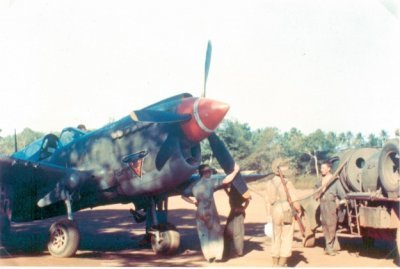
[Enclosed photo from BeeldBank NIMH. Click on photo for ordering information]
Curtiss P-40E Warhawk
Note: No information is known.
See http://www.adf-serials.com.au/research/nei.htm
Curtiss P-40s RNMFS
| US Fiscal Year nr.
US Fiscal Year nr.
|
Date in service
Date in service
|
Date out of service
Datum uit dienst
|
Notes
Notes
|
||
|---|---|---|---|---|---|
| Curtiss P-40E-1 | |||||
| 41-24791 | |||||
| Curtiss P-40F & P-40F-15 | |||||
| 41-13638 | |||||
| 41-13732 | |||||
| 41-13781 | |||||
| 41-14012 | 15-09-1943 | Crashed | |||
| 41-14013 | |||||
| 41-14027 | |||||
| 41-14070 | |||||
| 41-14078 | |||||
| 41-14124 | |||||
| 41-14126 | |||||
| 41-14144 | |||||
| 41-14188 | |||||
| 41-19775 | |||||
| 41-19786 | 09-07-1943 | Crashed during landing at JAAB | |||
| 41-19875 | |||||
| 41-19885 | |||||
| 41-19886 | 04-08-1943 | Crashed because of ground loop | |||
| 41-19948 | |||||
| Curtiss P-40L-5 | |||||
| 42-10497 | 08-10-1943 | Landing accident JAAB | |||
| Curtiss P-40N-1 & P-40N-5 | |||||
| 42-104768 | |||||
| 42-104788 | |||||
| 42-104808 | 06-07-1943 | Landing accident | |||
| 42-104828 | |||||
Curtiss P-40N Kittyhawk
The serials of the NEIAF were changed from midst of August 1945. For the remaining Curtiss P-40s the C3-5XX serials became J-3XX
Note: in the listing below the column "Date in service" is the first date the aircraft was added to the inventory of 120 squadron.
| Serial
Serial
|
Tail-code & colour of spinner
Tail-code & colour of spinner
|
2nd Serial
2nd Serial
|
US Fiscal Year nr.
US Fiscal Year nr.
|
Nickname
Nickname
|
Date in service
Date in service
|
Date out of service
Date out of service
|
Notes
Notes
|
|
|---|---|---|---|---|---|---|---|---|
| Curtiss P-40N-20-CU | ||||||||
| C3-500 | Y | Red | J-300 | 43-22972 | Nebukadnezar Buffalo-badge on starboard |
01-01-1944 | 09-06-1947 | Written of after emergency landing |
| C3-501 | J-301 | 43-22974 | 01-01-1944 | 28-12-1948 | Crashed near Sapoeran | |||
| C3-502 | B | Blue | J-302 | 43-22975 | Spit Kitty [Poublon] Buffalo-badge on starboard |
01-01-1944 | 09-03-1949 | Belly landing at Perwakarta; Written of 01-05-1949 |
| Red | Miss Carriage [Brameijer] Buffalo-badge on starboard |
|||||||
| C3-503 | Red | 43-22976 | Wham Bham Buffalo-badge on starboard |
01-01-1944 | 19-09-1944 | Mid air collision with C3-544 | ||
| C3-504 | - | 43-22977 | 01-01-1944 | 01-08-1944 | Emergency landing in sea after attack on Maniokwari. | |||
| C3-505 | - | J-305 | 43-22978 | Don Quichote (starboard) | 01-01-1944 | 08-1947 | Date wfu unknown; 08-1947 Dismantled for spare parts at 1-VRA; Written of May 1948 |
|
| C3-506 | - | 43-22979 | 01-01-1944 | 14-11-1944 | Crash at Merauke | |||
| C3-507 | - | 43-22980 | 01-01-1944 | 17-12-1948 | Carried (fake) RAAF serial A29-503; Burned after belly landing at Kalibanteng. |
|||
| C3-508 | 43-22981 | 01-01-1944 | 24-08-1944 | engine caught fire during flight. | ||||
| C3-509 | D | Red | J-309 | 43-22982 | Mississipi Belle (starboard) | 01-01-1944 | 22-12-1948 | Crashed near Kaliangtrik. |
| C3-510 | J | - | J-310 | 43-22983 | 01-01-1944 | 05-05-1946 | Crash during ferry flight from Biak to Java on 20-04-1946 | |
| C3-511 | Red | J-311 | 43-22984 | Flying Dutchman (starboard) | 01-01-1944 | mid 1949 | To AURIS. | |
| C3-512 | Red | 43-22789 | Rocky (starboard)en Karaoki (parrot) port | 01-12-1943 | - | 07-02-1944 to NEI pool; Further history unknown |
||
| C3-513 | Red | 43-22790 | Karaoki (parrot) port | 01-12-1943 | 20-12-1944 | Crashed near Yass (Australia) | ||
| C3-514 | Red | 43-22793 | Mata Hari Buffalo-badge on starboard |
01-12-1943 | 25-07-1944 | Crash during practice flight | ||
| C3-515 | Red | 43-22799 | Gooney Bird (starboard) [partouille Mulder] | 01-12-1943 | 05-07-1944 | Crash landing near Cooks Bay; Written of |
||
| Amigo(port) en Karaoki (parrot) starboard [De Raadt] | ||||||||
| C3-516 | J-316 | 43-22762 | 01-12-1943 | mid 1949 | To AURIS | |||
| C3-517 | 43-22763 | 01-12-1943 | - | On 08-06-1944 to NEI pool; Further history unknown |
||||
| C3-518 | J-318 | 43-22769 | 01-12-1943 | 04-05-1946 | Crash because of AA fire. | |||
| C3-519 | 43-22771 | 01-12-1943 | 12-06-1945 | Written off after taxying accident | ||||
| C3-520 | P | J-320 | 43-22772 | Izzy the Injun (starboard); Indanenhead (port) | 01-12-1943 | 03-02-1949 | From 10-1948 and on as J-320 based at Photo VerkenningsAfdeling (recce unit) and had PVA badge applied; Belly landing at Tjililitan | |
| C3-521 | E | J-321 | 43-22774 | 01-12-1943 | 07-02-1946 | Written of | ||
| C3-522 | R | J-322 | 43-22775 | Patricia | 01-12-1943 | mid 1949 | To AURIS | |
| C3-523 | J-323 | 43-22777 | Letha (port) | 01-12-1943 | 29-11-1949 | Crash at Bundaberg; Written of 12-1949 |
||
| C3-524 | 43-22778 | 26-01-1944 | 29-03-1944 | Ex RAAF A29-600 received as replacement; Crashed near Mildura |
||||
| C3-525 | J-325 | 43-22784 | Nelly (port) | 26-01-1944 | 29-07-1947 | Ex RAAF A29-601 received as replacement; Shot near Magoewo |
||
| C3-526 | J-326 | 43-22804 | Buffalo-badge on starboard | 26-01-1944 | 22-08-1945 | Ex RAAF A29-607 received as replacement; Written of |
||
| C3-527 | 43-22757 | 26-01-1944 | 29-03-1944 | Ex RAAF A29-634 received as replacement; Crashed near Mildura |
||||
| C3-528 | 43-22985 | 15-02-1944 | 09-07-1945 | Ex RAAF A29-645 received as replacement; Crashed near Biak |
||||
| C3-529 | Yellow | J-329 | 43-22986 | Streamline Babe [Levy/A. De Jong] | 15-02-1944 | mid 1949 | Ex RAAF A29-646 received as replacement; To AURIS |
|
| Blue | Jinx [Simons/E. Poublon] | |||||||
| C3-530 | 43-22988 | 15-02-1944 | 30-08-1944 | Ex RAAF A29-648 received as replacement; Belly landing at Merauke |
||||
| C3-531 | J-331 | 43-22991 | 15-02-1944 | 17-03-1948 | Ex RAAF A29-650 received as replacement; Collison with tractor during take off. |
|||
| C3-532 | J-332 | 43-22995 | 15-02-1944 | 13-04-1949 | Ex RAAF A29-654 received as replacement; Belly landing at Solo and written off 01-05-1949 |
|||
| C3-533 | 43-23003 | 01-03-1944 | 17-02-1945 | Crash at Musselbroek | ||||
| Curtiss P-40N-25-CU | ||||||||
| C3-534 | J-334 | 43-24347 | 01-10-1944 | 01-08-1945 | Shot near Manokwari | |||
| C3-535 | G | J-335 | 43-24349 | 01-12-1945 | 23-06-1948 | Crashed near Canberra | ||
| C3-536 | J-336 | 43-24353 | 01-11-1944 | 13-12-1945 | Crashed near Bandoeng | |||
| C3-537 | J-337 | 43-24355 | 01-12-1945 | 04-1947 | Dismantled for spare parts at 1-VRA; 04-1948 Written off. |
|||
| C3-538 | J-338 | 43-24357 | 01-12-1945 | 29-01-1946 | Date entering service uncertain; Crash near PEP Bundaberg; Written off 22-02-1946 |
|||
| C3-539 | J-339 | 43-24537 | 01-07-1944 | 04-07-1945 | Crashed near Mokmer | |||
| C3-540 | 43-24540 | 01-07-1944 | 07-07-1944 | Landing accident at Merauke; Written off. |
||||
| C3-541 | Red | 43-24541 | Crazy Number 23 (starboard) | 01-09-1945 | 11-08-1945 | Crashed while strafing target; 16-08-1945 Written off |
||
| C3-542 | Blue ? | 43-24545 | The Harlem Hawk (starboard) | 01-09-1945 | 14-02-1945 | Groundloop at Tanhemerah; Dismantled for spare parts. |
||
| C3-543 | 43-24549 | - | - | 12-08-1944 crash at Amberley during test flight; Not delivered to NEI AF. |
||||
| C3-544 | 43-24548 | 01-09-1944 | 19-09-1944 | Mid air collision with C3-503 | ||||
| C3-545 | J-345 | 43-24552 | 01-08-1944 | 08-09-1944 | Crash at Merauke | |||
| C3-546 | J-346 | 43-24553 | 01-08-1944 | 19-07-1945 | Crash while lading at Middelburg I | |||
| C3-547 | J-347 | 43-24556 | 01-12-1945 | mid 1949 | To AURIS | |||
| C3-548 | J-348 | 43-24544 | 01-12-1945 | 14-02-1945 | Emergency landing near Yea Norht South Wales; Written off | |||
| Curtiss P-40N-30-CU | ||||||||
| C3-549 | H | Yellow | J-349 | 44-7195 | Snafu (starboard) | 01-09-1944 | mid 1949 | To AURIS |
| C3-550 | 44-7198 | 01-09-1944 | 19-09-1944 | Written off after emergency landing because of engine fire. | ||||
| C3-551 | 44-7200 | 01-09-1944 | 04-1948 | Written off | ||||
| C3-552 | P / R | J-352 | 44-7202 | Rhanie Thully | 01-12-1945 | 06-09-1949 | Landing accident at Andir; Written off | |
| C3-553 | 44-7207 | 01-09-1944 | 19-11-1944 | Crash during practice dive bombing. | ||||
| C3-554 | 44-7209 | 01-09-1944 | 10-12-1944 | Crash during attack of Lantar (Banda) | ||||
| Curtiss P-40N-35-CU | ||||||||
| C3-555 | J-355 | 44-7856 | 01-03-1945 | mid 1949 | Date entering service uncertain; To AURIS | |||
| C3-556 | J-356 | 44-7857 | 01-06-1945 | mid 1948 | Date entering service uncertain; To AURIS | |||
| C3-557 | J-357 | 44-7858 | 01-03-1945 | 18-07-1945 | Crashed North of Sorong | |||
| C3-558 | J-358 | 44-7859 | 01-06-1945 | mid 1949 | To AURIS | |||
| C3-559 | J-359 | 44-7860 | 01-06-1945 | mid 1949 | To AURIS | |||
| C3-560 | J-360 | 44-7861 | Irma (port) | 01-06-1945 | 18-11-1948 | Date entering service uncertain; Belly landing at Andir and written off |
||
| C3-561 | J-361 | 44-7862 | 01-03-1945 | 17-05-1946 | Crashed at Tjilililitan and Written off | |||
| C3-562 | 44-7863 | 01-03-1945 | 01-08-1945 | Ditched in sea near Manokwari | ||||
| C3-563 | J-363 | 44-7864 | 01-03-1945 | 06-1946 | Date entering service uncertain; Written off PEP Biak. |
|||
| C3-564 | J-364 | 44-7865 | 01-03-1945 | 06-1946 | Date entering service uncertain; Written off PEP Biak. |
|||
| C3-565 | J-365 | 44-7866 | Betty (starboard) | 01-03-1945 | mid 1949 | To AURIS | ||
| C3-566 | J-366 | 44-7867 | 01-12-1944 | 23-05-1945 | Date entering service uncertain; Further history unknown. |
|||
1/72nd scale
Kits
- Academy
- Kit 1668: A very good model of a Curtiss P-40N. It has spooked wheels added as where mainly used in NEIAF service.
- Kit 1671: Curtiss P-40E Warhawk
- Airfix
- Kit 01038: Curtiss P-40E Kittyhawk
- AZ Models
- Kit AZ 7400: Curtiss P40E Warhawk Special
- Kit AZ 7410: Curtiss P-40E Warhawk
- Kit AZL 7223: Curtiss P40E "Warhawk" "Aces" [uitgebracht onder Legato]
- Kit AZL 7222: Curtiss P40E "Warhawk" [uitgebracht onder Legato]
- Chematic
- Kit 002: Curtiss P-40E
- Hasegawa
- Kit XX: A good 1:72 model of the Curtiss P-40E Kittyhawk. For an extinguished description of this model I refer to MIP 1986, nr. 2. Here you can find an article about the Hasegawa Curtiss P-40N, but this is very useful for the P-40E.
- Kit BO10:350/ 510:500/...: A CurtissP-40N [with wheelcovers. The Dutch P-40Ns usually had the wheelcovers removed. For an extinguished description of this model I refer to MIP 1986, nr. 2.]
- HobbyBoss
- Kit 80250: A model of a Curtiss P-40E
- Kit 80252: A model of a Curtiss P-40N
- Heller
- Kit 80266: Curtiss P-40E
- Special Hobb
- Kit SH72155: Curtiss P-40F Warhawk
- Kit SH72298: Curtiss P-40F/L Warhawk "Checkertails"
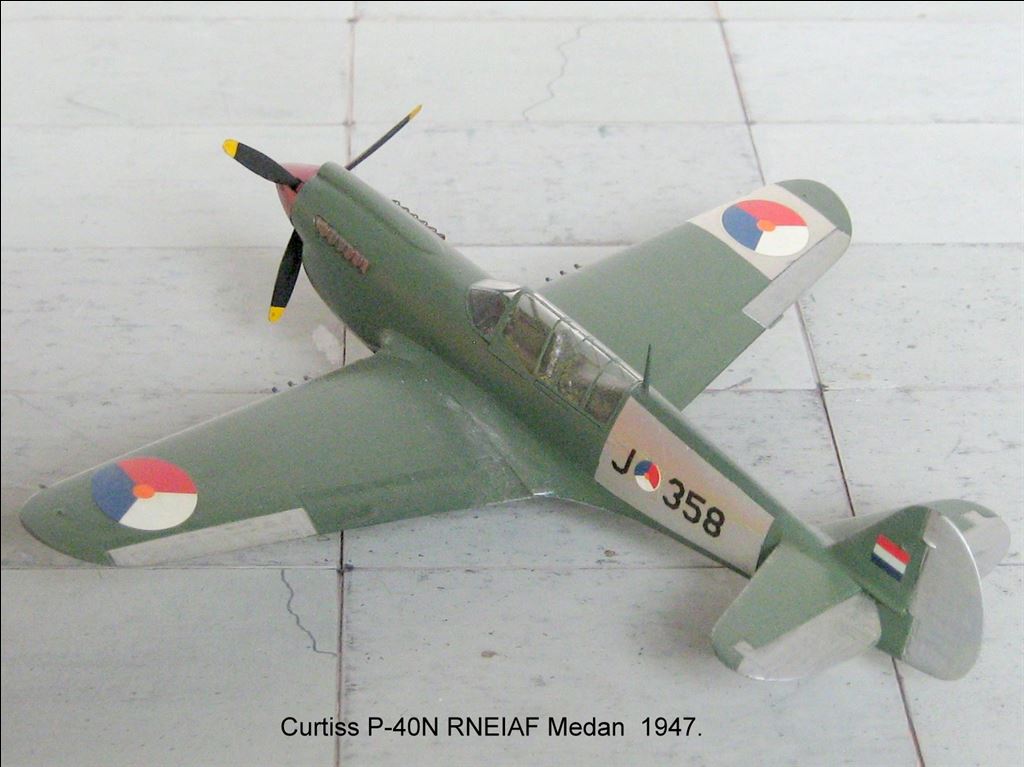
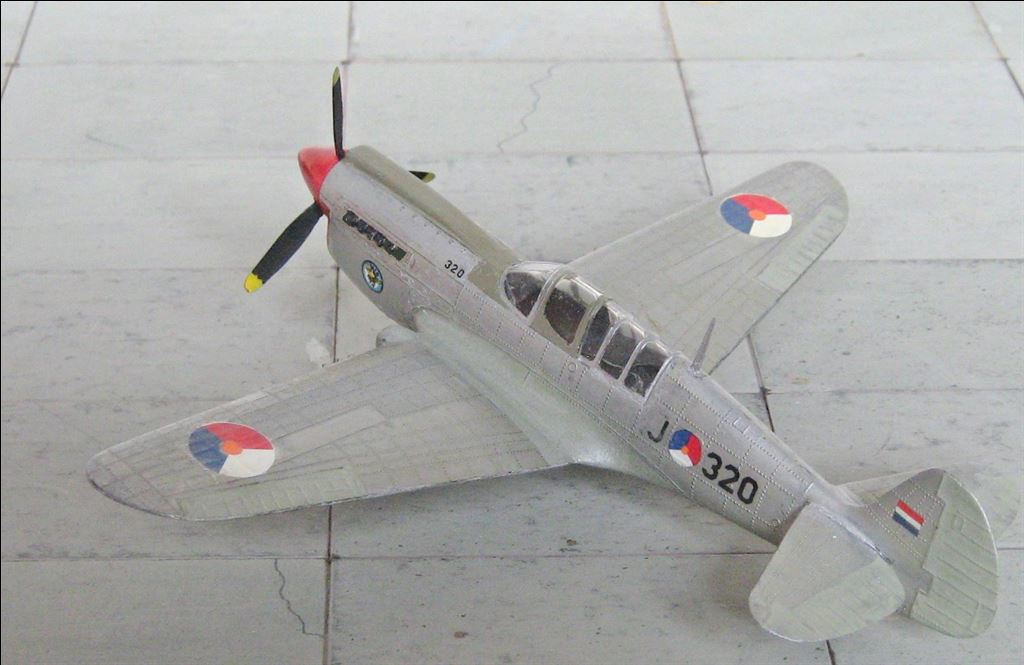
Modelling add-on
- Aires
- Set 7023: Curtiss P40N Warhawk Cockpit Detail Set
- Set 7284: Curtiss P40M/N Wheels and paint mask (Academy)
- Set 7278: Curtiss P40B/E Wheelbay (Airfix)
- Set 7257: Curtiss P40 Warhawk wheels (Academy)
- Set 7253: Curtiss P40 Warhawk wheel bays (Academy)
- AirWaves
- Set SC7231: Curtiss P40F Late Nose & Tail
- Set SC7232: Curtiss P40F Early Nose
- Set AC7254: Detailset Curtiss P40 Tomahawk
- AML Models
- Set A72033: Curtiss P40/P36/H75 Hawk Wheels and Masks
- Set A7211: Curtiss P40B/C/E/M/N Wheel wells
- CMK
- Set A7249: Curtiss P40E/M/N Armament set (Academy)
- Set A7250: Curtiss P40E/M/N Undercarriage set (Academy)
- Set A7251: Curtiss P40E/M/N Control surfaces set (Academy)
- Eduard
- Set SS121: Detailset Curtiss P40M/N Warhawk (Academy)
- Set E72-419: Detailset Curtiss P40E Kittyhawk Landing Flaps (Hasegawa)
- Set E72-420: Detailset Curtiss P40E Kittyhawk (Hasegawa)
- Set E72-313: Detailset Curtiss P40M/N Warhawk (Academy)
- Extra Tech
- Set 72105: Curtiss P40M/N Kittyhawk (Academy)
- Set 72106: Curtiss P40M/N Kittyhawk Flaps (Academy)
- Falcon
- Set VAX46: Canopies USAF Part 4
- Kora Models
- Set 7275: Curtiss P40 Warhawk wheels with disc
- Part Etchings
- Set S72-125: Canopy Frames Curtiss P40D/N
- Set S72-126: Canopy Frames Curtiss P40N
- Set S72-105: Curtiss P40N Warhawk (Hasegawa, Academy)
- Set S72-122: Curtiss P40E Warhawk (Academy, Hasegawa)
- Rexx
- Set 72.002: Curtiss P40N/M Exhausts
- SBS
- Set 72025 : P40N Warhawk wheels set (27" diamond tread)
- Squadron
- Set 09133: Canopies Curtiss P40N Warhawk
- True Details
- Set 72458: Curtiss P40E/N Cockpit Detail Set
- Set 72010: Curtiss P40E/M Wheel Set
- Verlinden
- Set 00001451: Curtiss P40N Update set
- Eduard
- Set SS121: Detailset Curtiss P40M/N Warhawk (Academy)
- Set E72-419: Detailset Curtiss P40E Kittyhawk Landing Flaps (Hasegawa)
- Set E72-420: Detailset Curtiss P40E Kittyhawk (Hasegawa)
- Set E72-313: Detailset Curtiss P40M/N Warhawk (Academy)
- Wurmcastings
- Set 7212: Curtiss P40 U/C Bay with P40N diamond tread wheels with spoked hubs.
- Set 7213: Curtiss P40 6 gun wing detail set, commonwealth type
- Set 7214: Curtiss P40 6 gun wing detail set, US type
- Set 7215: Curtiss P40 Allison V1710 engine with poanels, exhausts and acc
- Set 7210: Curtiss P40 early U/C Bay with block tread wheels.
- Set 7211: Curtiss P40 early U/C Bay with diamond tread wheels.
Decals
- AeroMaster
- A set for several aircraft such as the aircraft on the photo shown in Koku-Asahi 48-03
- Dutch Decal
- Set 72020: A decal set for several aircraft such as P-40N C3-503 "Wham Bam"and C3-512 "Rocky"
- Set 72032: A decal set for several aircraft such as P-40N J-320
- FlevoDecal
- Set FD72-003: A decal set for e.g. Hurricane, C47, P40N, B25 Mitchell
- Dutch Profile
- Set DDS97248: A decalset for Curtiss P40E/N (RNEIAF)
- Set DDS107248: A decalset for Curtiss P40N Warhawk (RNEIAF)
- FlevoDecal
- Set FD72-003: Decalset for aircraft such as Hurricane, C47, P40N and B25 Mitchell
1/48th scale
Kits
- Arii
- Kit 332-800: Curtiss P40E Warhawk
- Hasegawa
- Kit 2409924: Curtiss P40N Warhawk "Natural Metal"
- Kit 24sp304/2409966/2409789/24JT86: Several releases of the Curtiss P40E
- HobbyCraft
- Kit 1413: Curtiss P40F "Deserthawk"
- Kit 1417: Curtiss P40F/L Allied
- Kit 1417: Curtiss P40F/L Checkertails
- Italeri
- Kit 2717: Curtiss P40E/K Kittyhawk
- Mauve
- Kit 00081: Curtiss P40N Warhawk
- Revell
- Kit 04566: Curtiss P40E Warhawk
- Aires
- Set 4268: Curtiss P40E Warhawk cockpit detail set (Hasegawa)
- AML Models
- Set A48011: Curtiss P40 Detail set
- Set A48044: Curtiss P40 (early) Wheels and Masks
- Avionix
- Set CS48012: Curtiss P40E Warhawk resin Cockpit set (Hasegawa)
- Set CS48013: Curtiss P40N Warhawk resin Cockpit set (Hasegawa)
- Brengun Model Accessories
- Set BML48014: Curtiss P40M,N Warhawk canopy rails (Eduard/Mauve)
- CMK
- Set Q48013: Curtiss P40E/M/N wheels
- Cutting Edge
- Set BM48155: Curtiss P40E to P40M Wheel Hub Masks
- Set BM48226: Curtiss P40N Warhawk Canopy/Wheel Hub Masks (Mauve/Eduard)
- Eduard
- Set E49-652: Detailset Curtiss P40E/K Self Adhesive (Italeri)
- Set E49-356 / FE356: Detailset Curtiss P40E Kittyhawk MKIII (Hasegawa)
- Set E49-333: Detailset Curtiss P40N Warhawk (Hasegawa)
- Set BIG4838: Detailset Curtiss P40N Warhawk (Hasegawa)
- Set E49-314: Detailset Curtiss P40E Warhawk (Hasegawa)
- Set E48-403: Detailset Curtiss P40N/M Flaps (Mauve)
- Set E48-223: Detailset Curtiss P40N Warhawk Flaps (AMT)
- Set E48-135: Detailset Curtiss P40N Warhawk (Mauve)
- Extra Tech
- Set 72105: Curtiss P40M/N Kittyhawk (Academy)
- Set 72106: Curtiss P40M/N Kittyhawk Flaps (Academy)
- Hi-Tech
- Set 48003: Curtiss P40D/E Tail Conversie
- Master, reality in Miniature
- Set AM-48-025: Curtiss P40E-N fairings with blast tubes for .50cal Browning (6pcs).
- Moskit
- Set MT4857: Curtiss P40E Fish tail exhaust (Revell).
- Set MT4858: Curtiss P40 Fish tail exhaust (Eduard/Mauve).
- Part Etchings
- Set S48139: Detailset Curtiss P40K/M/N Flaps (Hasegawa)
- Set S48138: Detailset Curtiss P40N-5/-40 Warhawk (Hasegawa)
- Set S48137: Detailset Curtiss P40D/E/F/L Flaps (Hasegawa)
- Set S48136: Detailset Curtiss P40E Kittyhawk (Hasegawa)
- QuickBoost
- Set 48041: Curtiss P40E Kittyhawk Exhaust (Hasegawa).
- Rob Taurus Canopies
- Set 48046: Canopy Curtiss P40N Warhawk (Hasegawa)
- Set 48025: Canopy Curtiss P40E Warhawk (Hasegawa)
- Set 48011: Canopy Curtiss P40N Warhawk (Eduard/Mauve)
- Squadron
- Set 09527: Canopies Curtiss P40 Tomahawk
- Set 09537: Canopies Curtiss P40E Kittyhawk
- Set 09569: Canopies Curtiss P40N Warhawk
- Set 09597: Canopies Curtiss P40F/K
- True Details
- Set 48451: Curtiss P40N Warhawk Cockpit detail set
- Set 48451: Curtiss P40N Warhawk Cockpit detail set
- Set 48015: Curtiss P40E/M Wheel Set
- Set 48055: Curtiss P40E/N Warhawk Wheel Set
- Yahu Models
- Set A4814: Instrument Panel Curtiss P40E Warhawk (Hasegawa).
Decals
- Dutch Decal
- Set 48041: decalset for e.g. P40N RNMFS Jackson Sharkmouth, S51, "Jezebel", F16 323 sq "Sharkmouth", Auster LSK
- Dutch Profile
- Set DDS97248: decalset for Curtiss P40E/N (RNEIAF)
- Set DDS107248: decalset for Curtiss P40N Warhawk (RNEIAF)
- FlevoDecal
- Set FD48-003: Decalset for aircraft such as Hurricane, C47, P40N, B25 Mitchell
The P-40E's were originally meant for the USAAC and had the standard USAAC paint scheme scheme applied. The Dutch red-white and blue flag was painted over the US markings on fuselage and undersides of the wings.
The rest of the US markings were painted over, most probably with available paint, such as "Donker Blad": The flag was also applied on the under surfaces of the wings.
The Curtiss P-40Ns initially also had the standard USAAF colour scheme of olive drab over neutral grey.
| Scheme | Colour name | FS number | Humbrol | XtraColor | VAllejo ModeColor | |
|---|---|---|---|---|---|---|
| Standard #1 | Upper surfaces | US Dark Olive Drab 41 | ~4088 | H66 | X111/X112/X113 | 70.887 |
| US Medium Green 42 (spots on some P-40N) | ~4092 | 149 | X114 | 70.895 | ||
| Undersides | US Neutral Grey 43 | abt ~6173 | Mix: 1*156 + 1*34 (H176) | X133/X207 | 70.992 | |
Check www.paint4models.com for an extensive conversion table with lots of colour and paint systems.
Below some examples of colour schemes of the Curtiss P-40N. Per individual aircraft this may differ, depending on the period, but also from the pilots, who often gave a name to their personal aircraft.
Both "Dutch Profile" issues, written by ax Schep and Luuk Boerman you may find a large quantity of photographs and lots of colour profiles.
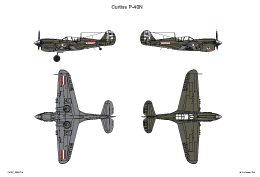
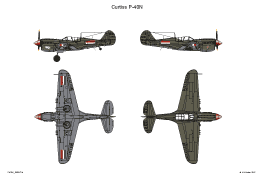
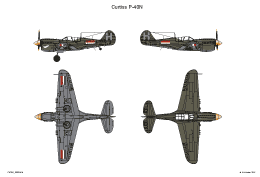
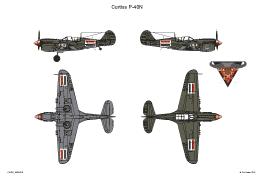
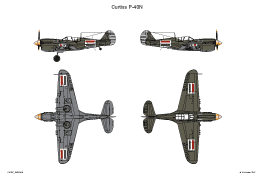
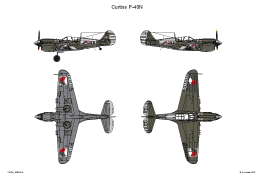
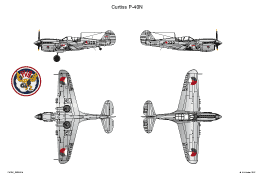
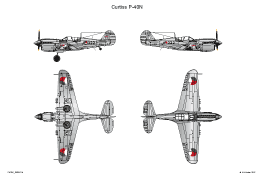
Literature.
| Van Glenn Martins en Mustangs | H.Hooftman | Pag. 160 - 164 | 1967 | La Rivière & Voorhoeve, Zwolle |
| Aircraft Number 26: Curtiss P-40 in action | Ernest R. McDowell | Pag. 16 - 21; 43 - 55 | 1976 | Uitgever Squadron/Signal Publications Inc., Carrolton, Texas |
| Militaire Luchtvaart in Nederlandsch-Indië in beeld, Deel 2 | Hugo Hooftman | Pag. 95 - 109 | 1981 | Uitgever Europese Bibliotheek, Zaltbommel |
| The Royal Netherlands Military Flying School 1942-1944: Bijdrage tot de Geschiedenis van het Zeewezen deel 16 | O.G. Ward & P.C. Boer | Pag. 105 - 112; 252 - 257 | 1982 | Uitgever Afdeling Maritieme Historie, 's Gravenhage |
| Squadrons van de Koninklijke Luchtmacht | Willem Helfferich | Pag. 48 | 1983 | Uitgever Unieboek b.v., Houten |
| Modelbouw in Plastic: nr.2: KNIL Nationaliteitskenmerken', dl. 2 | M. Schep | Pag. 26-29. | 1984 | Uitg. IPMS Nederland |
| Luchtvaartwereld; 3e jaargang nummer 4: De vliegtuigen van Jackson (2) | Gerard Casius | Pag. | 1986 | Uitgeverij Ten Brink Plaats: Meppel |
| Luchtvaartwereld; 3e jaargang nummer 3: De vliegtuigen van Jackson | Gerard Casius | Pag. 82 - 92 | 1986 | Uitgeverij Ten Brink Plaats: Meppel |
| Modelbouw in Plastic jaargang 15,: nr 1: De P-40N van het ML-KNIL, deel 1 | M.Schep & L. Boerman | Pag. 11 | 1986 | Uitg. IPMS Nederland |
| Modelbouw in Plastic jaargang 15,: nr 2: De P-40N van het ML-KNIL, deel 2 | M.Schep & L. Boerman | pag. 52 - 57 | 1986 | Uitg. IPMS Nederland |
| Modelbouw in Plastic jaargang 15,: nr 3: De P-40N van het ML-KNIL, deel 3 | M.Schep & L. Boerman | pag. 80 - 85 | 1986 | Uitg. IPMS Nederland |
| De Militaire Luchtvaart in Nederlands-Indië. | Pag. 23-24. | 1987 | De Bataafsche Leeuw; Amsterdam | |
| Luchtvaartwereld; 5e jaargang nummer 10: De Curtiss Kittyhawk in Indië | Gerard Casius | pag. 277 - 282 | 1988 | Uitgeverij Ten Brink, Meppel |
| 40 Jaar luchtvaart in Indië. | B. van der Klaauw, B.M. Rijnhout | Pag. 61, 82-83, 152. | 1989 | De Alk; Alkmaar |
| De luchtstrijd om Indië. | P.C.Boer e.a | Pag. 137, 181 | 1990 | Unieboek, Houten |
| NEIAF-colours and markings, SAFO, vol. 16, nr 7 (62) | J. Maas, | pag. 53-55 | April 1992 | |
| Squadrons van de Koninklijke Luchtmacht (derde herzien druk) | Willem Helfferich | Pag. 21 | 1994 | Uitgevers Wyt, Rotterdam |
| Camouflage en Kentekens | J.Greuter e.a. | 1997 | Bonneville – Bergen (NH) |
Websites.
- Curtiss P-40 Site
- P-40 Warhawksite
- Gerben Tornij's artikel over P-40E
- Warbird Alley: Curtiss P-40
- Go2War2
- Fighter Factory: Curtiss P-40
- Strijdbewijs: Curtiss P-40
- Wikipedia UK: Curtiss P-40
- Joe Baugher's Site: Curtiss P-40
- Details
- Hits: 14380
History
The Curtiss Model 33 was developed in September 1923 from the Curtiss R-6 race plane. The aircraft was purchased by the United States Army as PW-8 after a competition with the Boeing Model 15, which was designated PW-9. The Boeing was purchased as a main fighter.
The Curtiss P-1 Hawk was the first type in the United States Army Air Service receiving the P indicator (P = Pursuit). The P-1 was the production version of the Curtiss XPW-8B, an improved version of the PW-8 and had, at the request of the Air Service, the same type of wing as the Boeing PW-9.
The first P-1, Curtiss designation Model 34A, made its first flight in mid-August 1925 and soon several variants followed that differed primarily in engine equipment.
In March 1925 an order was received for the delivery of five P-1s equipped with the more powerful Curtiss V-1400 engine of 500 hp. These aircraft were designated XP-2. The first example of this series was modified and equipped with a turbocharger, which had been applied at the side of the nose.
However, the V-1400 did not met the expectations and it was replaced in three machines by the standard Curtiss C-1150. These aircraft were then designated as P-1.
The fifth P-2 also received another engine, a Curtiss Conqueror V-1570 and was designated as XP-6.
A total of 93 Hawks was produced in P-1 to P-1C variants. Also, 52 P-1 versions P-1D to P-1F were built. However, these types were conversions of mostly trainers like AT-4 and AT-9.
Also, a number of test aircraft were built. The P-3 was actually a P-1A equipped with a Pratt & Whitney R1340 Wasp radial engine. Initially, the intention was to equip this aircraft with the Curtiss R-1454 engine but this one proved to be to unreliable.
Four examples were built under the designation P-3A, which were mainly designed to test the engine.
Later, two of these aircraft were equipped with a Pratt & Whitney R 985-1 Wasp Junior and designated XP-21.
In 1928 five Curtiss P-5s, similar to the P-1C, but with a turbocharger, were delivered. The performance at higher elevations and the service ceiling were clearly better than that of the P-1C. However, performance at lower altitudes were less.
In total, 202 Curtiss Hawk variants were delivered.
Curtiss P-6
The first aircraft with the designation P-6 was the fourth P-2 (serial number 25-423) which was modified for the National Air Races of 1927 and was equipped with the Curtiss V-1570, later known as Conqueror. This engine was an development of the Curtiss D-12 engine.
The US Army therefore gave it the designation XP-6. This aircraft has been stripped of all military equipment and became second in the air race.
There was ordered to convert a P-1A, (Ser. No 26-295), which received a V 1570-1 Conqueror engine and the wings of the PW-8A, with radiators in the wing.
This version was given as a factory designation Model 34Q and was designated by the Army as XP-6A. This aircraft also took part in the air race of 1927 and reached the first place.
There was an order for 18 Curtiss Model 34P, army designation P-6. The first nine aircraft, serial number 29-260 t / m 29-268 had an engine that was cooled by Prestone, broadly comparable with glycol. This not only saves a lot of weight, but also reduces the radiator.
Due to delivery problems with Prestone-cooled engines, the other aircraft, serial number 29-269 were - 29-273 and 29-2 = 363 till 29-366 delivered water-cooled Curtiss V 1570-17 engines.
The rest of the series was delivered with Prestone-cooled engines, and designated as Curtiss P-6A
The P-6 was largely consistent with the P-1, but differed mainly in the more rounded hull so that it would connect to the Conqueror engine better.
Furthermore, the underside of the hull has been made deeper, so that it corresponds better to the bottom of the radiator. The suspension was adjusted and replaced by Oleo-spring system which is mounted on the front style.
Hawk I
Hawk I (or export Hawk) was the designation of the civilian and the export version of the Curtiss P-6. In 1930 a demonstration aircraft was built and usually flown by the famous aviator James Doolittle. This aircraft was known as the Doolittle Hawk.
See also the article about the Curtiss Hawk I at Avianet.eu
Versions.
Each version became heavier, causing to perform less than the previous version.
- XPW-8: Three prototypes, one was converted to XPW-8A and later to XPW-8B standard; one was converted into CO-X two seat scout.
- XPW-8A: modified prototype with new cooling system and adapted wings.
- XPW-8B: Curtiss Model 34 with modified wing as adapted to Curtiss P-1.
- PW-8: 25 examples of the production version
- P-1: Curtiss Model 34A – production version of the XPW-8B with modified rudder and some other smaller modifications and equipped with a Curtiss V-1150-1 rated 435 hp (324 kW); Ten examples built.
- P-1A: Model 34G – P-1 with extended fuselage (3 inch), larger wheels and revised fuel system; 25 examples built plus three modified P-2’s.
- XP-1A: One P-1A used for development purposes
- P-1B: Model 34I – 25 examples built in 1928, equipped with a Curtiss V-1150-3 (D-12D) engine.
- P-1C: Model 34O - 33 examples built in 1927 – 1928, equipped with a Curtiss V-1150-5 (D-12E) engine.
- XP-1C: A P-1C with a revised radiator.
- P-1D: 24 converted AT-4 trainers; equipped with a Curtiss V-1150-3 (D-12D) engine.
- P-1E: 4 converted AT-5 trainers equipped with a 328 kW Curtiss V-1150-3.
- P-1F: 24 converted (in 1929) AT-5A trainers plus one converted XP-21A; equipped with a 328 kW Curtiss V-1150-3.
- P-2: Model 34B – Five P-1s equipped with a Curtiss V-1400 rated 500 hp.
- Three of these aircraft were later converted to P-1A; another on was equipped with a Curtiss V1570 engine an designated XP-6.
- XP-3: Converted P-1A equipped with a Curtiss R-1454 radial engine rated 390 hp. later modified to XP-3A.
- XP-3A: XP-3 equipped with a Pratt & Whitney R-1340-1 radial engine rated 410 hp
- XP-21: XP-3A equipped with a Pratt & Whitney R-985 Wasp Junior radial engine.
- P-3A: Model 34N – Production version of the AT-5A, fice examples built , equipped with an Pratt & Whitney R-1340-7 radial engine rated 410 hp.
- XP-4: Modified P-1A with a turbocharged Packard 1A-1530 engine rated van 510 hp.
- XP-5: P-1A equipped with a Curtiss V-1150-3 engine rated 435 hp.
- P-5: Model 34L – production version of the XP-5, later equipped with a Curtiss D-12F engine; Four examples built.
- XAT-4: Model 34J - One P-1A equipped with a Wright-Hispano E rated 180 hp for the advanced training.
- AT-4: production version of the XAT-4, 40 examples ordered. The first 35 examples were modified in 1929 to P-1Ds with a Curtiss D-12 engine; the remaining five were finished as AT-5s.
- AT-5: Model 34J – Five modified AT-4s with a Wright J-5 rated 220 hp; later modified to P-1E.
- AT-5A: Model 34M – based upon the P-1B with an extended fuselage ; 31 examples built; later modified to P-1Fs.
- XP-6: Model 34P, modified P-1 equipped with a Curtiss V-1570-17 engine.
- XP-6A: Model 34K, as XP-6 but with different wings and wing radiators.
- P-6A 18 examples built for US Army.
- XP-6B: Modified P-1 equipped with a V-1670 engine.
- XP-6D: XP-6B, equipped with a turbocharged Curtis V-1570-C engine.
- P-6D: Modified P-6As (6 examples) in 1932 equipped with a turbocharged Curtiss V-1570-C.
- XP-6E: Model 35, also referred to as Y1P-22, built in July 1931 as prototype of the P-6E
- XP-6F: Modified XP-6E with a turbocharger and enclosed cockpit.
- P-6E: 46 examples delivered in 1931-1932
- XP-6G: A P-6E equipped with a Curtiss V-1570F engine.
- XP-6H: A P-6E with four .30 in (7.62 mm) machine guns in the wings.
- P-6S Hawk I: Three examples sold to Cuba, equipped with a450 hp Pratt & Whitney R-1340 Wasp radial engine plus one sold to Japan as Japan Hawk with a Curtiss V-1570 inverted V-engine.
| Dimensions: | |||
| Length: | 6,71 m | Wing span: | 9,60 m |
| height: | 2,78 m | Wing surface: | 23,40 m2 |
| Weights: | |||
| Empty weight: | 1154 kg | Full Weight: | 1662 kg with a filled belly tank, a total amount of 378 l fuel. |
| Performance: | |||
| Max. speed: | 278 km/u | Climbing speed: | 8,3 min to 4000 m |
| Range: | 690 km with 378 l fuel | Service ceiling: | 6750 m |
| Miscellaneous: | |||
| Engine: | One Curtiss Conqueror V1570, 640 pk (471 kW) at 2400 rpm | ||
| Crew: | One | ||
| Armament: | One .50 Colt-Browning machine gun, plus one .30 Colt-Browning machine gun | ||
Information about Dutch aircraft..
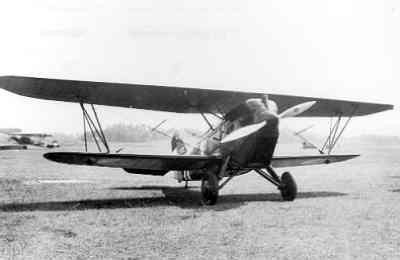
[Enclosed photo from BeeldBank NIMH. Click on photo for ordering information]

[Enclosed photo from BeeldBank NIMH. Click on photo for ordering information]
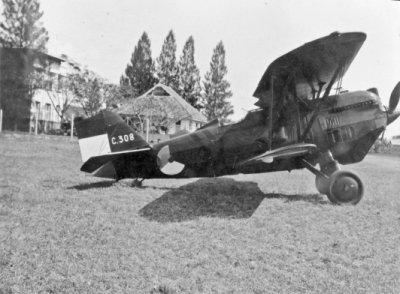
[Enclosed photo from BeeldBank NIMH. Click on photo for ordering information]
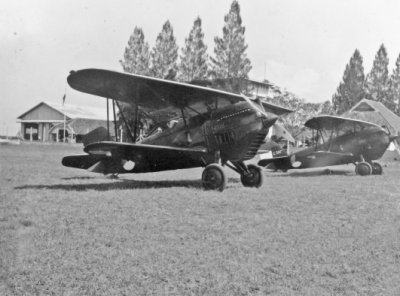
[Enclosed photo from BeeldBank NIMH. Click on photo for ordering information]
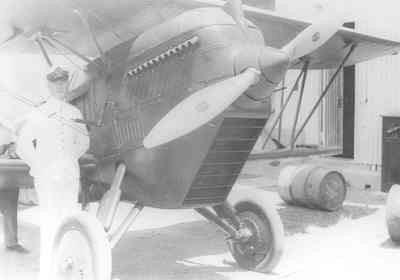
[Enclosed photo from BeeldBank NIMH. Click on photo for ordering information]
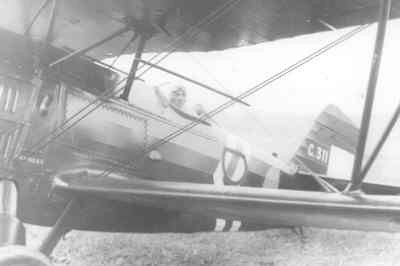
[Enclosed photo from BeeldBank NIMH. Click on photo for ordering information]
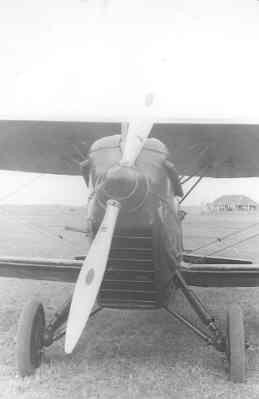
[Enclosed photo from BeeldBank NIMH. Click on photo for ordering information]
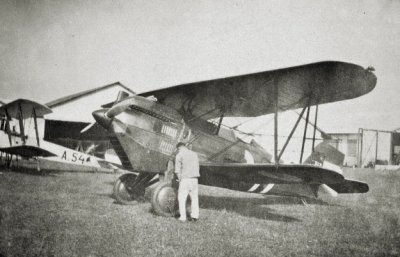
[Enclosed photo from BeeldBank NIMH. Click on photo for ordering information]
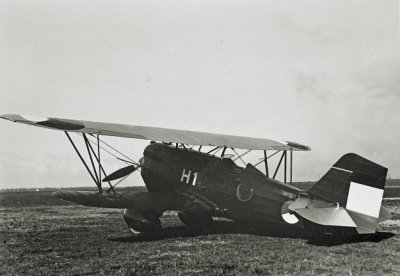
[Enclosed photo from BeeldBank NIMH. Click on photo for ordering information]
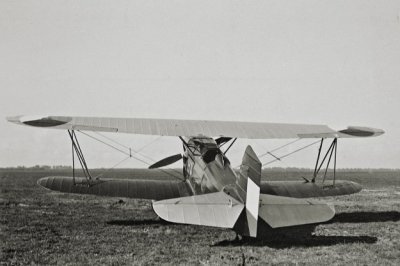
[Enclosed photo from BeeldBank NIMH. Click on photo for ordering information]
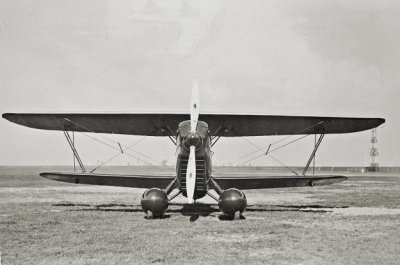
[Enclosed photo from BeeldBank NIMH. Click on photo for ordering information]
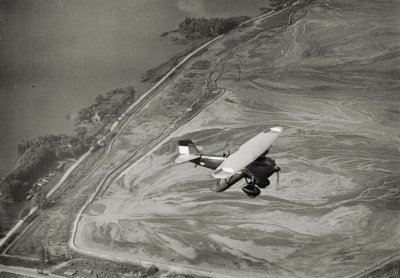
[Enclosed photo from BeeldBank NIMH. Click on photo for ordering information]
| Serial | Construction nr. | Date in service | Date out of service | Notes |
|---|---|---|---|---|
| Ordered 1929. Built and delivered by Curtiss | ||||
| C-306 | ||||
| C-307 | ||||
| C-308 | 27-02-1936 | Collided against C-3?? | ||
| C-309 | 15-02-1935 | Crashed near Tangkoebanprahoe | ||
| C-310 | ||||
| C-311 | ||||
| C-312 | 18-11-1930 | Crashed near Andir and written off. | ||
| C-313 | ||||
| C-314 | ||||
| Ordering date 1929, Build under license by Aviolanda, Papendrecht, The Netherlands | ||||
| C-315 | ||||
| C-316 | ||||
| C-317 | ||||
| C-318 | ||||
| C-319 | ||||
| C-320 | ||||
1/72nd Scale
Of the Curtiss Hawk I thus far no model has been released. Below an overview of related Curtiss types.
The Hawk of the NEIAF was an export version of the Curtiss Hawk (certainly it wasn't a Curtiss P.6E, which was released later!!) with a conversion of the engine cowling. The nose section was quite similar to that of the Curtiss P.1C.
- ArdPol
- Kit 72-042: Curtiss A-3B Falcon
- LF Models
- Kit 72065: Curtiss P-1C
- Monogram
- Kit 6794-0108: Curtiss P-6E Hawk
- Pro Resins
- Kit R72-023: A resin model of a Curtiss P-2 Hawk
- Kit R72-021: A resin model of a Curtiss P-1B Hawk
- Kit R72-001: A resin model of a Curtiss P-1 Hawk
- Kit R72-004: A resin model of a Curtiss P-1A hawk
Modelling add-on
- --
- Set --: --
Decals
- --
- Set --: --
1/48th Scale
Kits
- --
- Kit --: --
Modelling add-on
- --
- Set --: --
Decals
- --
- Set --: --
| Scheme | Colour name | FS number | BS-nummer | Humbrol | WEM | Vallejo Model Color | Vallejo Model Air | |
|---|---|---|---|---|---|---|---|---|
| Standard #1 | Fuselage | Khaki | LVA Olive green AC D04 | 70.921 | ||||
| Upper-side wings etc. | Aluminium dope | ~7178 | 191 | 70.864 | 71.062 | |||
Check www.paint4models.com for an extensive conversion table with lots of colour and paint systems.
Literature.
| Militaire Luchtvaart in Nederlandsch-Indië in beeld. Deel 1 | Hugo Hooftman | Pag. 90 - 103 | 1978 | Uitgever Europese Bibliotheek, Zaltbommel |
| Air Enthusiast 26: The famed Curtiss Hawks | Peter M. Bower | Pag. 54 - 71 | 1984 | Uitgever Pilot Press Ltd., Bromley, Kent |
| Nederlandse vliegtuigen naar buitenlands ontwerp | Theo Wesselink & Thijs Postma | pag. 41 | 1984 | Uitgever Romen Luchtvaart, Haarlem |
| 40 Jaar luchtvaart in Indië | Gerard Casius & Thijs Postma | pag. 34, 49 | 1986 | Uitgeverij De Alk, Alkmaar |
| Van Aviolanda tot Fokker | P. van Wijngaarden | pag. 37 - 39 | 1987 | Uitgever De Klaroen, Alblasserdam |
| Camouflage en Kentekens | J.Greuter e.a. | 1997 | Bonneville – Bergen (NH) |
Websites.
Special thanks to G. Casius for the very useful information and drawings regarding the Curtiss Hawk I he was so kind to sent me.
H. Berfelo for providing me with some additional information.
- Details
- Hits: 19892
History
The Curtiss Hawk 75 was developed in 1933/1934 as a private initiative of the Curtiss factory. The all-metal aircraft had a Wright XR 1670-5 radial engine of 900 horsepower.
The prototype was equipped with a .30 inch and .50 inch machine gun, at that time the standard armament of the USAAC.
The prototype made its first flight on May 6, 1935.
Later that month there was a USAAC competition for the delivery of a new fighter.
However, the P-35 Seversky competitor crashed on the flight to Wright Air Force Base, Ohio, and had to be rebuilt.
Curtiss had therefore time to improve the aircraft and exchanged the engine for a Wright XR 1820-30 of 910 horsepower and gave the renewed machine the designation Curtiss 75D, while the first prototype was designated as Curtiss 75B.
Unfortunately Seversky won the competition. However, because of the increasing tensions, especially in Europe, Curtiss received in June 1936 a contract to supply three test aircraft, designated Y1P-36 fitted with a Pratt & Whitney R1830-13 Twin Wasp rated 900 hp .
These performed very well, so in 1937 an order for 210 examples, designated as P-36A followed. Because of a variety of childhood diseases such as blistering of the aircraft skin at the wheel well, problems with the exhaust and weaknesses in the airframe, the aircraft was not used much operational, so it was considered to be outdated when the problems were solved and became the type was transferred to training units.
France was already interested in the type before the P-36A entered in production. But because the Curtiss 75 costs almost twice as much as the French Bloch MB150 and Morane MS406, after a period and mainly because of the political tensions a first order for 100 Curtiss 75 A-1 or H75-SC1 with Pratt & Whitney R-SC -1830-G and French equipment. France received over 300 aircraft.
Versions.
- Curtiss 75A:
- demonstration aircraft, which was equipped with different engines.
- Curtiss-75A-1: 100 examples for France with R-1830 SC-G 900 hp and four 7.5 mm machine guns.
- Curtiss 75A-2: 100 examples for France with R-1830 SC-G or R-1830 SC3-G 1050 hp and six 7.5 mm machine guns.
- Curtiss 75A-3: Third series for France; Built 135 aircraft; 133 delivered.
- Curtiss 75A-4: Last series for France and 75A-2 with Wright R-1820-G205A Cyclone 1,200 hp; Built 200 examples; 81 aircraft were delivered; rest taken over by the RAF as Mohawk IV.
- Curtiss 75A-5: License Building in China, later to India. Later entered service as Mohawk IV with the RAF.
- Curtiss 75A-6: version for Norway. After invasion sold to Finland.
- Curtiss 75A-7: Version for the Dutch East Indies with Wright R-1820 Cyclone 1200 hp; one .50 inch and one .303 inch machine gun in the nose and two .303 inch machine guns in the wings; later changed to two .303 inch machine guns in the nose; bomb load of 2 x 50 lbs (23 kg)
- Curtiss 75A-8: version for Norway used for training in Canada; Later to Peru.
- Curtiss 75A-9: 10 examples for Persia. Taken over by the RAF as Mohawk IV.
- Curtiss 75B:
- first prototype with Wright R-1820 engine.
- Curtiss 75D:
- Prototype with Wright R-1670 engine.
- Curtiss 75E:
- Three aircraft for testing by the USAAC with USAAC designation Y1P-36
- Curtiss 75H:
- simplified version with fixed landing gear, supplied to China and Argentina.
- Curtiss 75i:
- factory designation of Curtiss YP-37, equipped with an Allison V-1710 of 1150 horsepower.
- Curtiss 75J:
- Curtiss 75A equipped with turbo-supercharger.
- Curtiss 75K:
- a non-built version with a Pratt & Whitney R-2180 Twin Hornet.
- Curtiss 75L:
- Factory Name of the P-36A
- Curtiss P-36A: Production version for USAAC
- Curtiss P-36B: P-36A temporarily fitted with an R 1830-20 of 1,100 horsepower.
- Curtiss P-36C: last 30 examples of USAAC series P-36As with R 1830-17 of 1,200 horsepower and a .303 machine gun in each wing.
- Curtiss XP-36D: A P-36A with two .50 inch machine gun in the nose and four .303 inch machine guns in the wings.
- Curtiss XP-36E: Standard P-36A with four .303 inch machine guns in the wings.
- Curtiss XP-36F: P-36A experimental equipped with two 23 mm Madsen cannons.
- Curtiss P-36G: designation of Curtiss 75A-8
- Curtiss 75M:
- simplified version with fixed landing gear and Wright R-1820 for China, built by Curtiss and in China.
- Curtiss 75O:
- Simplified version with fixed undercarriage; 30 examples built for Argentina and another 20 aircraft built under license by Fabrica Militar de Aviones.
- Curtiss 75P:
- Production 36A (38-010) with Allison V-1710 inline engine; prototype for the Curtiss P-40.
- Curtiss 75Q:
- Two demonstration aircraft for China.
- Curtiss 75R:
- 75A Curtiss R-1830 SG2-R turbo supercharger.
- Curtiss 75S:
- Factory Display for XP-42 test device for research of cooling of liquid-cooled inline engines.
| Dimensions: | |||
| Length: | 8,7 m | Wingspan: | 11,28 m |
| Height: | 2,82 m | Wing area: | 21,9 m2 |
| Weights: | |||
| Empty weight: | 2121 kg | Max. start weight: | 2661 kg |
| Performances: | |||
| Max. speed: | 518 km/hr | Rate of climb: | 762 m/min |
| Range: | 1046 km | Service ceiling: | 9860 m; |
| Miscellaneous: | |||
| Engine type: | One Wright Cyclone GR-1820-G205A rated 1200 Hp. | ||
| Crew: | |||
| Armament: | Four 7.7 mm machine guns: two wing mounted, two nose mounted. Two bombs of 50 kg each |
||
In service with NEIAF.
The Curtiss Hawks were ordered in September 1939 because of the threat of war. From May 1940, the aircraft were rapidly delivered to the Dutch East Indies.
A follow-up order of 24 examples was not honoured by the U.S. government for a lack of large motors due to the increased threat and act of war.
At Andir was the "1e jacht afdeling", the first figther group, was formed.
At the end of November 1941 there were probably 12 Hawks stationed at Maospati, Java. At the time of the attack there were probably about fifteen Hawks operational.
During February 1942 the remaining Hawks were withdrawn from operational use, because of the unreliable engines.
When the Netherlands East Indies capitulated no Hawk was left.
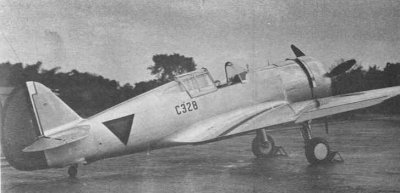
[Enclosed photo from BeeldBank NIMH. Click on photo for ordering information]
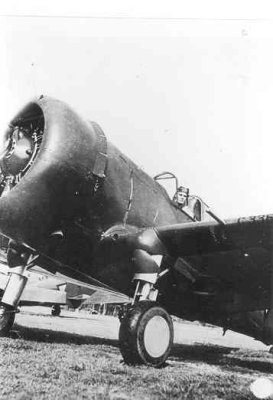
[Enclosed photo from BeeldBank NIMH. Click on photo for ordering information]

[Enclosed photo from BeeldBank NIMH. Click on photo for ordering information]

[Enclosed photo from BeeldBank NIMH. Click on photo for ordering information]
| Serial
Seria
| Construction nr.
Construction nr.
| Date in service
Date in service
| Date out of service
Date out of service
| Notes
Notes
|
|---|---|---|---|---|
| C-310 | 05-1940 | |||
| C-311 | 05-1940 | |||
| C-312 | 05-1940 | |||
| C-313 | 05-1940 | |||
| C-314 | 05-1940 | |||
| C-315 | 05-1940 | |||
| C-316 | 05-1940 | |||
| C-317 | 05-1940 | |||
| C-318 | 05-1940 | |||
| C-319 | 05-1940 | |||
| C-320 | 05-1940 | |||
| C-321 | 05-1940 | |||
| C-322 | 05-1940 | |||
| C-323 | 05-1940 | 05-02-1942 | V.d. Poel; Shot down near Madioen | |
| C-324 | 05-1940 | |||
| C-325 | 05-1940 | 05-02-1942 | V.d.Does de la Bije; Shot down near Soerabaja; | |
| C-326 | 05-1940 | |||
| C-327 | 05-1940 | |||
| C-328 | 05-1940 | |||
| C-329 | 05-1940 | 21-12-1941 | Van Breen; Collision in the air after take-off from Medan | |
| C-330 | 05-1940 | |||
| C-331 | 05-1940 | 21-12-1941 | Mulder; Shot by RAF during landing on te Ipoh (?) and destroyed in emergency landing | |
| C-332 | 05-1940 | 05-02-1942 | Hermans; Emergency landing near Maospatina after dog fight | |
| C-333 | 05-1940 | 21-12-1941 | Sanders; Collision in the air after take-off from Medan | |
| C-334 | 05-1940 | |||
| C-335 | 05-1940 | 05-02-1942 | Dröger; Shot down near Soerabaja | |
| C-336 | 05-1940 | |||
| C-337 | 05-1940 | 05-02-1942 | Dijkman; Shot down near Soerabaja | |
| C-338 | 05-1940 | |||
| C-339 | 05-1940 | |||
| C-340 | 05-1940 | |||
| C-341 | 05-1940 | |||
| C-342 | 05-1940 | |||
| C-343 | 05-1940 | |||
| C-344 | 05-1940 | |||
| C-345 | 05-1940 |
1/72nd Scale
Kits
- AML Models
- Kit 7209: Curtiss Hawk 75A-4 "Mohawk IV"
- Azur
- Kit 013: Curtiss P36/H75A-4 Mohawk IV
- Intech
- Kit 72022: Curtiss H-75A3
- Smer
- Kit 0841: Curtiss P36/H75 Hawk
- Special Hobby
- Kit SH72053: Hawk H75A-3 "European war"
- Kit SH72052: P-36A "Pearl Harbour"
Modelling add-on
- AML Models
- Set 7213: Curtiss H75A-1/2/3/6 Hawk Detail set
- Squadron Signal
- Set 9115: Canopies P36/P40B (Toma)Hawk
- Airwaves
- Set SC7238: Curtiss P36 Mohawk MK4 Wright Engine (also for Dutch Hawk!)
- Kora Models
- Set 7274: Curtiss Hawk H75 wheels
- Reheat
- Set TH088: Detailset P36/H75 Mohawk
Decals
- Dutch Decal
- Set 72023: Set voor verschillende toestellen zoals Curtiss Hawk C-329 met oranje driehoeken
- Set 72052: Set voor verschillende toestellen waaronder twee Curtiss Hawk 75A-7
- FlevoDecal
- Set FD72-012: Set met opties voor vijf Brewsters, Curtiss Hawk 75, Curtiss CW-21 en CW-22; Messerschitt Bf 108, Ryan STM, Lockheed 12 en Lodestar, Bücker Bu-131 en Martin WH-1 en WH-2
- Kora Models
- Set DEC 72.318: Curtiss Hawk H75A-7 (KNIL-ML)
1/48th Scale
Bouwpakketten
- Hobbycraft
- Kit 1557: Curtiss Hawk 75M/N/O
- Kit 1456: Curtiss Allied Hawk
Modelling add-on
- AML Models
- Kit A4803: Curtiss P36A/C, Hawk 75A1-6 Control surfaces and flaps (Hobbycraft/Academy)
- Kit A4804: Curtiss P36A/C, Hawk 75A1-6 Cockpit set, Undercarriage (Hobbycraft/Academy)
- Eduard
- Set E48-070: Detailset Curtiss H75/P36 Hawk (Flaps)
- Marti Kuivalainen
- Set E48008: Detailset Finnish Curtiss Hawk 75A interior (Academy)
- Squadron Signal
- Set 9568: Canopies Curtiss P36/A75 Hawk
Decals
- FlevoDecal
- Set FD48-012: Set for aircraft such as vijf Brewsters, Curtiss Hawk 75, Curtiss CW-21 en CW-22; Messerschitt Bf 108, Ryan STM, Lockheed 12 and Lodestar, Bücker Bu-131 and Martin WH-1 ND WH-2
| Scheme | Colour name | FS number | BS number | Humbrol | XtraColor | Vallejo Model Color | Vallejo Model Air | |
|---|---|---|---|---|---|---|---|---|
| Standard #1 | Overall | Bare metal | ||||||
| From mid 1940 and on | ||||||||
| Standard #2 | Upper surfaces | Jongblad (medium Green) | ~4092 | 149 | X114 | 70.885 ? | 71.014 | |
| Oudblad (Olive Drab) | 66 | X111 | 70.889 | 71.034 | ||||
| Undersides | Aluminium dope | ~7178 | 191 | X216 | 70.864 | 71.062 | ||
Check www.paint4models.com for an extensive conversion table with lots of colour and paint systems.
Literature.
| Aircraft Number 26: Curtiss P-40 in action | Ernest R. McDowell | pag. 4 - 6 | 1976 | Uitgever Squadron/Signal Publications Inc., Carrolton, Texas |
| Militaire Luchtvaart in Nederlandsch-Indië in beeld, Deel 2 | Hugo Hooftman | Pag. 17 - 23 | 1981 | Uitgever Europese Bibliotheek, Zaltbommel |
| 40 Jaar luchtvaart in Indië | Gerard Casius & Thijs Postma | Pag. 52 | 1986 | Uitgeverij De Alk, Alkmaar |
| Squadrons van de Koninklijke Luchtmacht (derde herzien druk) | Willem Helfferich | pag. 18 | 1994 | Uitgevers Wyt Plaats: Rotterdam |
| Camouflage en Kentekens | J.Greuter e.a. | 1997 | Bonneville – Bergen (NH) |
Websites.
- Walk Around
- Walk Around: onderstel
- Walk Around: Motor
- Walk Around: Cockpit
- Walk Around: Onderzijde
- Aviation History.: Curtiss P-36
- Military Factory
- Joe Baugher's site
- Wikipedia UK: Curtiss P-36
- Details
- Hits: 11520
History
The Caudron G.IV was a development of the single engined Caudron G.III. This aircraft, a reliable scout had as he disadvantage that no weapons could be carried. The first flight of the Caudron G.IV was in March 1915.
The wingspan had been enlarged, four rudders and two engines were added, so an armed gunner/observer and a bomb load of 100 kg could be carried.
The aircraft was used as scout and bomber and could penetrate the German. Later, when improved German fighters entered service, the Caudron G.IV was used for nightly operations.
The Caudron G.IV was used by Belgium, France, Finland, England and the US.
A total of 1358 examples were built in France plus an additional 51 examples by A.E.R., Italy and 12 examples by the British Caudron factory.
Versions.
Three versions were built:
- Caudron A2:
- a scout, equipped with radio;
- Caudron B2:
- a bomber, could carry 100 kg bombs;
- Caudron E2:
- a trainer with double steering.
The Caudron G.IVB was an armoured version.
| Dimensions: | |||
| Length: | 7,19 m | Wingspan: | 16,85 m |
| Height: | 2,55 m | Wing area: | - m2 |
| Weights: | |||
| Empty weight: | 733 kg | Max. start weight: | 1232 kg |
| Performances: | |||
| Max. speed: | 130 km/hr | Rate of climb: | 15 minutes to 2000 m |
| Range: | 5 hours | Service ceiling: | 4000 m |
| Miscellaneous: | |||
| Engine type: | Two Le Rhône 9C rated 80 hp | ||
| Crew: | Two men | ||
| Armament: | One 7 mm Lewis or Hotchkiss machine gun in the nose. The crew usually also had a carbine or a Chauchat gun. |
||
In service with LVA.
In 1915 five examples of this two seat bomber were ordered, but because of the war there were many problems to transport the aircraft to the Netherlands. Because of these problems the aircraft arrived on June 24, 1918.
As they had been stored for
a long period of time, a complete overhaul was necessary.
The Caudron G.IV was completely outdated in 1918 and were mainly just for reconnaissance duties.
In 1925 the Caudron G.IV was withdrawn from use.
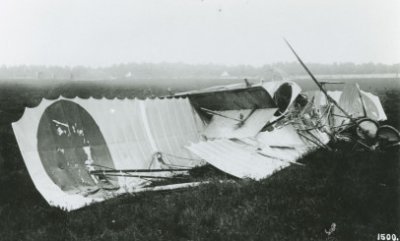
[Enclosed photo from BeeldBank NIMH. Click on photo for ordering information]
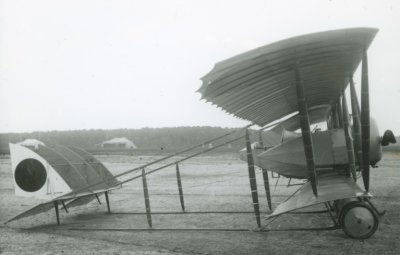
[Enclosed photo from BeeldBank NIMH. Click on photo for ordering information]
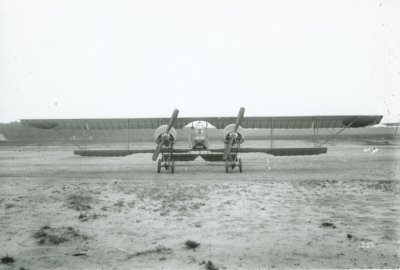
[Enclosed photo from BeeldBank NIMH. Click on photo for ordering information]
| Serial | Constructionr. | French serial | Date in service | Date out of service | Notes |
|---|---|---|---|---|---|
| C427 | 24-06-1918 | 01-11-1918 | Collided above Soesterberg with Farman HF-22 HF19. | ||
| C428 | 24-06-1918 | 1925 | |||
| C429 | 24-06-1918 | 1925 | |||
| C430 | 24-06-1918 | 1925 | |||
| C431 | 24-06-1918 | 1925 |
1/72nd Scale
Kits
- Phoenix Models
- Kit Xx: A vacu formed model of a Caudron G.IVA 2
Modelling add-on
- --
- Set --: --
Decals
- --
- Set --: --
1/48th Scale
Kits
- AJP Maquettes
- Kit --: Caudron G4
Modelling add-on
- --
- Set --: --
Decals
- --
- Kit --: --
| Scheme | Colour name | FS number | Humbrol | XtraColor | Vallejo Model Color | Vallejo Model Air | |
|---|---|---|---|---|---|---|---|
| Standard #1 | Fuselage | White | ~7875 | 34 | 70.951 | ||
| Wooden parts | Varnish | 100 ? | 70.818 | ||||
| Linen parts | Dope | 41 | 70.918 | ||||
Check www.paint4models.com for an extensive conversion table with lots of colour and paint systems.
Literature.
| Nederlandse Militaire Luchtvaart in Beeld.,deel 1. | Hugo Hooftman | pag. 50 | 1977 | Uitgever Europese Bibliotheek, Zaltbommel |
| Squadrons van de Koninklijke Luchtmacht (derde herzien druk) | Willem Helfferich | Pag. 13 | 1994 | Uitgevers Wyt, Rotterdam |
| Camouflage en Kentekens | J.Greuter e.a. | 1997 | Bonneville – Bergen (NH) | |
| Air Enthusiast no.80, The Historical Aviation Journal: Unexpected Windfalls | Bart van der Klaauw | Pag. 54 - 59 | 1999 | Uitgever Key Publishing, Stamford |
Websites.
- Details
- Hits: 35300
History
historical description.
Versions.
description of versions
| March 02, 1942 the Americans left a PBY-4 (P-3) at Tjilatjap. The RNlNAS (MLD) repaired the aircraft and it was flown to Australia. It was returned to the US Navy March 07, 1942 (or handed over to RAAF?) |
|||
| Dimensions: | |||
| Length: | 19,47 m | Wing span | 31,72m |
| Height: | 6,15 m | Wing area: | 130,6 m2 |
| Weights: | |||
| Empty weight | 7950 kg | Max start weight: | - kg |
| Performance: | |||
| Max. speed: | 288 km/hr | Cruising speed: | 172 km/hr |
| Range: | 4096 km | Service ceiling: | 4481 m |
| Miscellaneous: | |||
| Engine type: | Two Pratt & Whitney R-1830-72 Twin Wasp rated 1050 hp each. | ||
| Crew: | Seven men ? | ||
| Armament: | |||
| Dimensions: | |||
| Length: | 19,84 m | Wing span | 31,72m |
| Height: | 5,4 m | Wing area: | 129,3 m2 |
| Weights: | |||
| Empty weight | 7824 kg | Max start weight: | 15 424 kg |
| Performance: | |||
| Max. speed: | 304 km/hr | Cruising speed: | 185 km/hr |
| Range: | 4810 km | Service ceiling: | 4481 m |
| Miscellaneous: | |||
| Engine type: | Two Pratt & Whitney R-1830-92 Twin Wasp rated 1200 hp each | ||
| Crew: | Seven man | ||
| Armament: | Four machine guns; 1814 kg bombs. | ||
| Dimensions: | |||
| Length: | 19,84 m | Wing span | 31,72m |
| Height: | 5,4 m | Wing area: | 129,3 m2 |
| Weights: | |||
| Empty weight | 9489 kg | Max start weight: | 16 066 kg |
| Performance: | |||
| Max. speed: | 281 km/hr | Cruising speed: | 181 km/hr |
| Range: | 3781 km | Service ceiling: | 4481 m |
| Miscellaneous: | |||
| Engine type: | Two Pratt & Whitney R-1830-92 Twin Wasp rated 1200 hp each | ||
| Crew: | Seven man | ||
| Armament: | Five machine guns and 1814 kg bombs | ||
| Boeing Canada built the PBY-5 under licence. These aircraft were delivered under the designation PB2B-1. The first examples were delivered in March 1943. Totally 240 PB2B-1's were built. 193 of which were delivered to RAF, RAAF and RNZAF, under Lend-Lease conditions, designated as Catalina Mk IVB. |
|||
| Dimensions: | |||
| Length: | 19,84 m | Wing span | 31,72m |
| Height: | 5,4 m | Wing area: | 129,3 m2 |
| Weights: | |||
| Empty weight | - kg | Max start weight: | - kg |
| Performance: | |||
| Max. speed: | km/hr | Cruising speed | |
| Range: | Service ceiling: | ||
| Miscellaneous: | |||
| Engine type: | Two Pratt & Whitney R-1830-92 Twin Wasp rated 1200 hp each. | ||
| Crew: | Seven men | ||
| Armament: | Seven machine guns; 1814 kg bombs | ||
|
PBY-6A/ OA-10B/ PB2B-2/ Catalina Mk VI: The first of this new versions, PBY-6A, was delivered in April 1944. Used were the developments which were used for the PBN-1. |
|||
| Dimensions: | |||
| Length: | 19,84 m | Wing span | 31,72m |
| Height: | 5,4 m | Wing area: | 129,3 m2 |
| Weights: | |||
| Empty weight | - kg | Max start weight: | - kg |
| Performance: | |||
| Max. speed: | - km/hr | Cruising speed:: | - km.hr |
| Range: | - km | Service ceiling: | - m |
| Miscellaneous: | |||
| Engine type: | Two Pratt & Whitney R-1830-92 Twin Wasp rated 1200 pk each | ||
| Crew: | Seven men ? | ||
| Armament: | 7 machine guns; 1814 kg bombs | ||
Period September 1941 till March 1942
May 1940 the delivery of long range patrol aircraft to the RNlNAS in Dutch East Indies, suddenly came to an end, when the Netherlands were overrun by the Germans. About one third of the ordered Dorniers Do-24 were delivered.
Because the allies already used the PBY and the RNlNAS was already interested in this type in 1937, it was an easy choice. After lot of negotiations an order for the delivery of 38 PBY-5 was made.
These aircraft received registrations Y-38 till Y-73.
After a short time a second order of another twelve aircraft, registered Y-74 t/m Y-85 was made. Because production had changed to the PBY-5A amphibian and this type was more useful, this order was changed in the delivery of twelve PBY-5As.
The first two flying boats, registered Y-38 and Y-39, were delivered on September 5, 1941. During the ferry Y-50 was damaged at Wake Island and repaired at the factory. During the attack of Pearl Harbour, on December 7, 1942, Y-68 was lost. Y-69, which was at Pearl Harbour, was confiscated by the US. It was returned to the Dutch in March 1942.
Because of the Japanese attack, another ferry route via Africa and Asia was necessary. Y-50 and Y-71 - Y-73 arrived via this route at Surabaya. Because of the critical circumstances at Singapore Y-52 till Y-54 were handed over to the RAF Singapore on October 15, 1941. They were detached at no. 205 squadron.

[Enclosed photo from BeeldBank NIMH. Click on photo for ordering information]
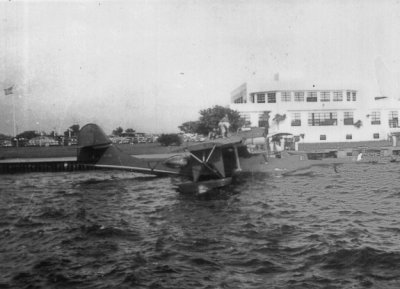
[Enclosed photo from BeeldBank NIMH. Click on photo for ordering information]

[Enclosed photo from BeeldBank NIMH. Click on photo for ordering information]

[Enclosed photo from BeeldBank NIMH. Click on photo for ordering information]

[Enclosed photo from BeeldBank NIMH. Click on photo for ordering information]

[Enclosed photo from BeeldBank NIMH. Click on photo for ordering information]
Losses
In the mean time several aircraft were lost:
- Y-38 sunk on February 9, 1942 during a rescue operation.
- Y-39 was used as training aircraft at Morokrembang and is possibly destroyed there by own military.
- Y-40 was shot down during a training flight on February 3, 1942.
- Y-41 was possibly lost in action.
- Y-42 was possibly lost in action.
- Y-43 was destroyed due to Japanese attacks.
- Y-44 crashed on December 5, 1941.
- Y-46 was damaged beyond repair during take off on October 7, 1941.
- Y-47 crashed in a landing in the night of February 22 to February 23, 1942.
- Y-48 was destroyed by own personnel on march 3, 1942.
- Y-50 was destroyed due to Japanese attacks.
- Y-51 was lost during a patrol mission on January 21, 1942.
- Y-58 was lost while bombing the Japanese fleet near Kema.
- Y-61 was destroyed due to Japanese attacks.
- Y-63 was shot down during a patrol flight on February 27, 1942.
- Y-65 was damaged on February 27, 1942 during an aerial fight.
- Y-66 caught fire due to Japanese attack on march 4, 1942.
- Y-72 was destroyed due to Japanese attacks.
Period after March 9, til VJ day
After the Dutch East Indies had surrendered on March 9, 1942, many crew escaped. Y-55, Y-56, Y-57 and Y-64 arrived at Koggala, Ceylon. Y-45, Y-59, Y-60, Y-67, Y-70 and Y-71 arrived in Australia. Due to the an expected attack of Broome on march 3, 1942 Y-59, Y-60, Y-67, Y-70 were lost.
Several personnel of RNlNAS managed to repair a PBY-4 of the US Navy. The unofficial serial P-3 was applied to the aircraft and flew to Australia. After an overhaul it was handed over to the RAAF. The aircraft, which arrived at Koggala were detached in no 222 group.
April 11, 1942 it was decided to form a Dutch navy squadron at Ceylon, equipped with the Catalina's. The five Catalina's in Australia were flown to Ceylon. By the end of may 1942 squadron 321 RAF was re-activated and detached at China Bay. The squadron stayed in no. 222 Group Coastal Command.
September 2,1942 PBY-5A Y-74 arrived as reinforcement. Soon the other eleven ordered PBY-5A's arrived. All these aircraft were equipped with radar.
Unfortunately Y-75 hit a rock and sunk. It could be rescued and repaired, but it was no longer useful for operational use. It was modified for transport of passengers and nicknamed Sky Sleeper.
Between October 11 and November 1, 1942 three PBY-5's, Y-69 being one of them were based at Mombassa [operation DemCat], Kenya because of the presence of a Japanese raider. Also because of the lack of radar equipped aircraft the patrols were of no use.
November 8, 1942 Y-71 was lost during a test flight, thus reducing the operational strength to just eight aircraft.
From December 15, 1942 four PBY-5A's were based at Ratmalana, Ceylon. besides the usual patrol flights the aircraft were used for special duties such as dropping or picking up espionage groups. Due to enemy submarine activities near Cape of Good Hope,
By the end of January 1943 6 PBY-5A's and 3 PBY-5's (Y-83; Y-85) were based at Darling, South Africa. The aircraft had English roundels and a small orange triangle applied. The amphibians were based at Darling and St.Albans (Det/Darling and Det/St.Albans; Det = Detachment); the flying boats were based at Durban (Det/Durban). April 8, 1943, Det/Durban was dismissed adn the boats returned to Ceylon.
By the end of May a storm damaged the camp of Det/Darling in such a way that they had to move to Brooklyn Air Station. September 19, 1943, Det/Brooklyn was dismissed and the aircraft were based on the isle of Socotra, Yemen. In October 1943 the aircraft of Det/St.Albans were also based at Socotra. December 30, 1944 Det/Socotra was dismissed.
Because of an engine failure Y-78/N was lost on December 9, 1943; Y-49/B was heavily damaged during a landing in the night by the end of December 1943. March 12, 1943 Y-45/A left for Australia (Det/Australia) to join the Do-24K, X-24. The aircraft had a large badge applied on the nose (Who can tell more about this??). The aircraft was mainly used for liaison duties for the Dutch intelligence services (NEFIS and NICA).
To replace the old Do-24K, X24, in June 1943 two new PBY-5's, Y-86 and Y-87 were added to Det/Australia. Y-86/U went soon, in July 1943, to Ceylon. Both aircraft had most probably a RAF camouflage pattern
August 25, 1943 Y-84/S was lost after a emergency landing because of lack of fuel.
April 23, 1944 again three Catalinas were based in South Africa, this time at Fasantekraal. In 1944 the old Y-55/C, Y-56/D and Y-64/G flying boats, which were already in use for training purposes, replaced with three PB2B1 Catalina IV's, registered Y-88/W, Y-89/X and Y-90/Y; August 1944 three other Catalina IV's were added, Y-91/Z, Y-92/B and Y-93/N. Al these aircraft were on loan from the RAF.
The aircraft were returned to the RAF in November and December 1944, when squadron 321 received their B-24 Liberators.
December 1945 Y-80 was withdrawn from use; Y-62, Det/Australia was lost because of an accident on October 13, 1945.
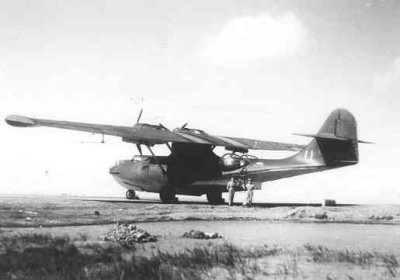
[Enclosed photo from BeeldBank NIMH. Click on photo for ordering information]

[Enclosed photo from BeeldBank NIMH. Click on photo for ordering information]

[Enclosed photo from BeeldBank NIMH. Click on photo for ordering information]

[Enclosed photo from BeeldBank NIMH. Click on photo for ordering information]

[Enclosed photo from BeeldBank NIMH. Click on photo for ordering information]
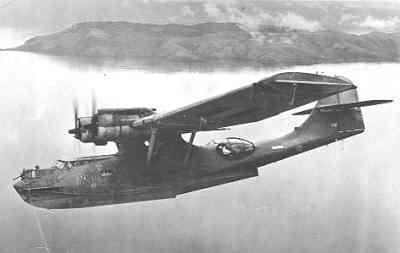
[Enclosed photo from BeeldBank NIMH. Click on photo for ordering information]
Period after VJ day
By the end of 1945 again six PB2B1 Catalina IVb's were taken over from the RAF. These aircraft also received serials Y-88 til Y-93.
From half July 1946 all aircraft were re-registered with P-serials. Initially the P was written actually as "P"on the fuselage, from 1947 it was applied as "16".
During 1946 seven flying boats were added, two Catalina I, serials P-200 and P-204 and four Catalina IVa's, registered P-201, P-202, P-203, P-205 and P-206 Catalina IVa's. The aged P-57, P-69 and P-74 could now bet withdrawn from use.
Alas P-87, P-204 and P 93 were lost because of accidents.
By the end of 1946 four PB2B2 Catalina VI's were bought in Australia, these were registered P-207 till P-210. These flying boats differs from the other aircraft mainly because of their changed tail unit.
In 1947 squadron 321 squadron was abolished. The remaining Catalina's were grouped together with the bought Dakota's in OVTS (Oostelijk Verkennings en Transport Squadron = Eastern Reconnaissance ad Transport Squadron).
In September 1948 OVTS was split up in GVTA (= Groep Vliegtuigen A = Aircraft Group A), equipped with four flying boats and five amphibians and GVTB (=Groep Vliegtuigen B), equipped with three flying boats.
with the transfer of sovereignty to Indonesia the "Commando MLD in de Oost (= Easter Command RNlNAS) was dismissed. A new unit, squadron 7, was formed in New Guinea and equipped with P-76, P-77, P-85, P-202, P-203 and 205. During 1950 squadron 321 was reactivated again and also based in New Guinea White Catalinas P-200, P-75, P-79, P-82 and P-83
In 1951 six PBY-5A was bought in the USA and completely overhauled in the Netherlands. These aircraft entered serviced registered P-211 till P-216. P-212 and P-216 stayed in the Netherlands for SAR-purposes. P-203, P-205, P-202 and P-200 could now be withdrawn from use. In 1951/1952 the old and worn P-77, P-75 and P-76 were withdrawn form use and scrapped. P-79,P-83 and P-85 were re-registered as P-217, P-218 and P-219.
End 1953 in Australia six more EX-RAAF Catalinas were bought. These entered service with serials P-220 till P-225, P-223 was scraped because of spare parts. The other Catalinas were completely overhauled and entered operational service in the beginning of 1954.
In 1957 all remaining Catalinas were withdrawn from use. Catalina P-217 (ex P-79) was preserved as a monument at air base Biak. When New Guinea was annexed by Indonesia, this aircraft, together with a preserved Firefly IV, was sold to an Australian scrapyard.
P-212 was preserved and donated to a swimming pool in the Netherlands. In 1984 it was exchanged with a Hawker Hunter and is, after being completely overhauled and now on display at the Militaire Luchtvaart Museum (MLM = Military Aviation Museum at Soesterberg). Recently this aircraft was completely overhauled by Stichting Neptune Association.
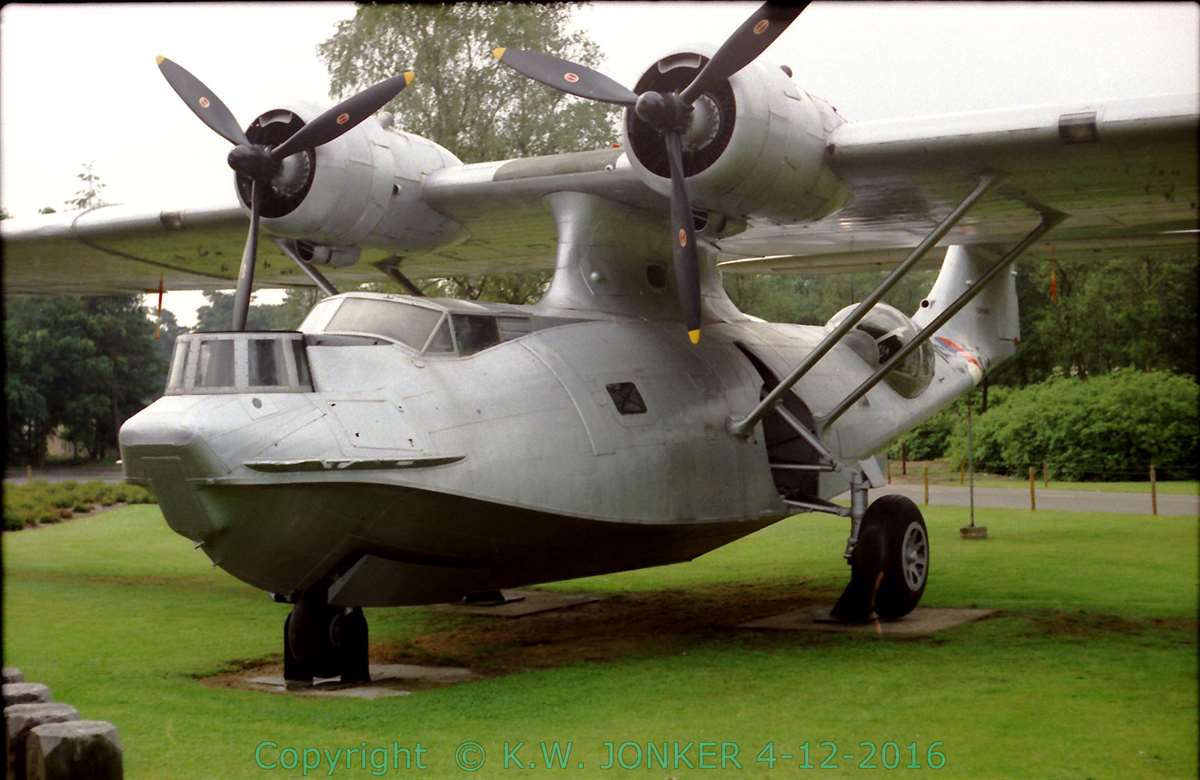
Catalina PBY-5A 212 photographed in 1985 at the Military Air force Museum at Soesterberg.
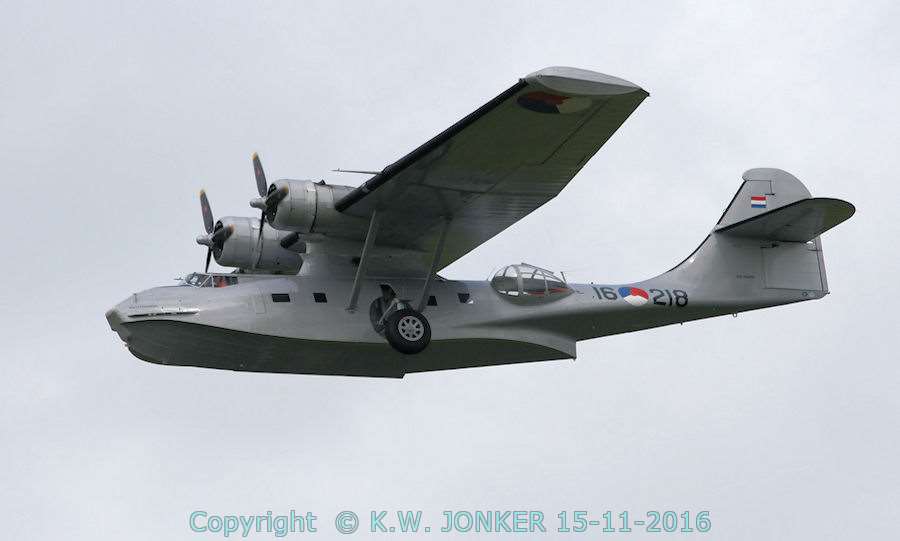
The Catalina PH-PBY of the Stichting Exploitatie Catalina PH-PBY.
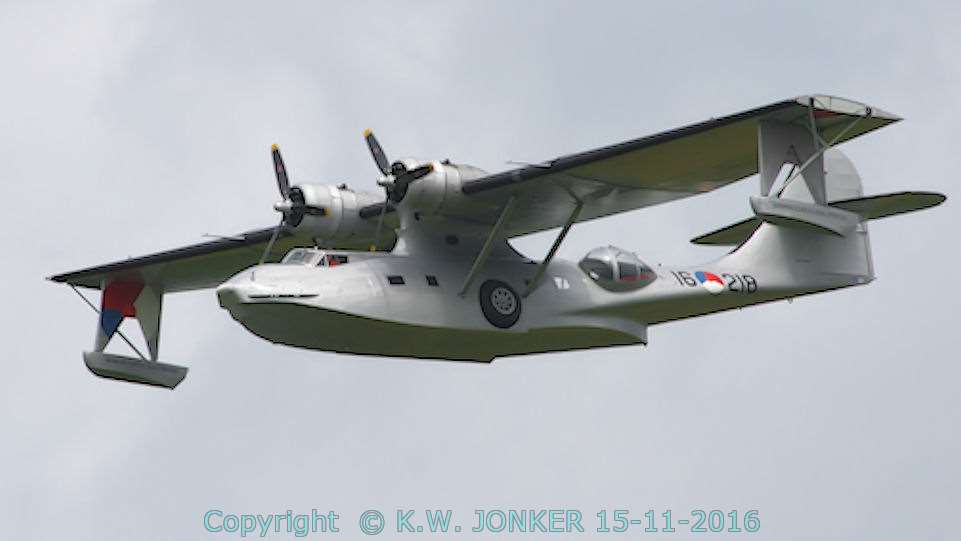
The Catalina PH-PBY of the Stichting Exploitatie Catalina PH-PBY.
Consolidated PBY-5/5A Catalina

|
|
Overview of the serials of the Dutch PBY-4, PBY-5, Catalina IVA, PBY-5A, , PB2B1 Catalina IVB and PB2B2 Catalina VI
Consolidated PBY-4 Catalina
| Serial | Construction nr. | Date in service | Date out of service | Notes |
|---|---|---|---|---|
| Y- 3 | - | 02-03-1942 | 07-03-1942 | March 02, 1942 left at Tjilatjap by the US. It was repaired by the Dutch Navy and flown (with evacuees) to Australia. Returned to the US on March 07, 1942. |
Consolidated PBY-5 Catalina
| Serial
Serial
|
2nd serial
2nd serial
|
Constr. nr.
Constr. nr.
|
Code
Code
|
Date in service
Datum in service
|
Date out of service
Datum out of service
|
Notes
Notes
|
|---|---|---|---|---|---|---|
| First series: Ordering date October 11, 1940. In January 1942 five aircraft were handed over to the USN (PatWing 10). They were registered P-41 till P-45. Corresponding Y-serials are unknown |
||||||
| Y-38 | 232 | 03-09-1941 | 09-02-1942 | Emergency landing Westervaarwater | ||
| Y-39 | 241 | 03-09-1941 | To USN Pat. Wing 10?? | |||
| Y-40 | 249 | 11-09-1941 | 03-02-1942 | Shot down near Madoera | ||
| Y-41 | 260 | 11-09-1941 | To USN Pat. Wing 10?? | |||
| Y-42 | 266 | 11-09-1941 | USN P-46 was rebuilt from the remains of RNLNAS Catalina (Y-42?) and of USN 22-P-12 | |||
| Y-43 | 276 | 23-09-1941 | To USN Pat. Wing 10?? | |||
| Y-44 | 293 | 23-09-1941 | 05-12-1941 | Crashed near Tandjong Pandan | ||
| Y-45 | 298 | A | Squadron 321 (Ceylon). Scrapped |
|||
| Y-46 | 301 | 08-10-1941 | To USN Pat. Wing 10?? | |||
| Y-47 | 303 | 08-10-1941 | 23-02-1942 | Crashed near naval air station Pontianak | ||
| Y-48 | 306 | 08-10-1941 | 03-03-1942 | Destroyed naval air station Pontianak | ||
| Y-49 | 308 | B | 12-10-1941 | (Ceylon). Scrapped | ||
| Y-50 | 311 | 16-01-1942 | To USN Pat. Wing 10?? | |||
| Y-51 | 315 | 12-10-1941 | 21-01-1942 | Sunk Barito river | ||
| Y-52 | 320 | 16-10-1941 | 04-12-1941 | To RAF, Singapore | ||
| Y-53 | 326 | 16-10-1941 | 4-12-1941 | To RAF, Singapore | ||
| Y-54 | 330 | 16-10-1941 | 4-12-1941 | To RAF, Singapore | ||
| Y-55 | 336 | C | 03-11-1941 | Squadron 321 (Ceylon). Scrapped, Ceylon |
||
| Y-56 | 340 | D | 03-11-1941 | Squadron 321 (Ceylon). Scrapped, Ceylon |
||
| Y-57 | 344 | E | 03-11-1941 | Squadron 321 (Ceylon). Scrapped naval air station Morokrembangan |
||
| Y-58 | 348 | 03-11-1941 | 11-01-1942 | Sunk near Kema | ||
| Y-59 | 351 | 09-11-1941 | 03-03-1942 | Sunk near Broome | ||
| Y-60 | 352 | 03-03-1942 | Sunk near Broome | |||
| Y-61 | 353 | 09-11-1941 | 03-02-1942 | Destroyed bombardment of naval air station Morokrembangan | ||
| Y-62 | 355 | F | 15-11-1941 | 18-10-1945 | Squadron 321 (Ceylon). Written off naval air station Biak |
|
| Y-63 | 358 | 15-11-1941 | 27-02-1942 | Shot down near Noordbroeder | ||
| Y-64 | 361 | G | 15-11-1941 | Squadron 321 (Ceylon). Scrapped, Ceylon |
||
| Y-65 | 363 | 02-12-1941 | 27-02-1942 | Written off, Tjilatjap | ||
| Y-66 | 367 | 02-12-1941 | 04-03-1942 | Destroyed bombardment of Tjilatjap | ||
| Y-67 | 369 | 02-12-1941 | 03-03-1942 | Sunk near Broome | ||
| Y-68 | 372 | 07-12-1941 | Destroyed bombardment of Pearl Harbor | |||
| Y-69 | P-69 | 376 | H | Squadron 321 (Ceylon). Scrapped |
||
| Y-70 | 378 | 03-03-1942 | Sunk near Broome | |||
| Y-71 | 381 | 8-11-1942 | Emergency landing Lake Bangalore | |||
| Y-72 | 385 | 05-02-1942 | Shot down near Waroe | |||
| Y-73 | 388 | To USN Pat. Wing 10?? | ||||
| Y-86 | P-86 | 8396 | U | 17-05-1943 | 08-01-1949 | Scrapped naval air station Biak |
| Y-87 | P-87 | 8397 | V | 17-05-1943 | 13-10-1946 | Crashed near Woendi and written off. |
Consolidated PBY-5 Catalina IVA
These aircraft were bought from RCAF, June 19, 1946.
Used in Dutch East Indies and (Dutch) New Guinea.
| Serial
Serial
|
2nd serial
2nd serial
|
Constr. nr.
Constr. nr.
|
RAF serial
RAF serial
|
Code
Code
|
Date in service
Date in service
|
Date out of service
Date out of service
|
Notes
Notes
|
|---|---|---|---|---|---|---|---|
| P-200 | DP202 | 17-09-1946 | 14-02-1952 | Scrapped at naval air station Biak | |||
| P-201 | JX206 | 17-09-1946 | 01-11-1949 | Written off at naval air station Morokrembangan | |||
| P-202 | JX572 | 17-09-1946 | 01-06-1950 | Written off naval air station Morokrembangan | |||
| P-203 | JX219 | 02-11-1946 | 05-10-1951 | Scrapped at naval air station Biak | |||
| P-204 | Z2137 | 26-12-1946 | 26-01-1947 | Crashed near Bali and written off. | |||
| P-205 | JX217 | 14-12-1946 | 14-11-1951 | Scrapped at naval air station Biak | |||
| P-206 | JX209 | 24-12-1946 | 1950 | In 1950 scrapped at naval air station Morokrembangan |
Consolidated PBY-5A Catalina
| Serial
Serial
|
2nd serial
2e serial
|
Fiscal Year nr.
Fiscal Year nr.
|
Constr. nr.
Constr. nr.
|
Code
Code
|
Date in service
Date in service
|
Date out of service
Date out of service
|
Notes
Notes
|
|---|---|---|---|---|---|---|---|
| Contract date 11-10-1940. In service at Ceylon (squadron 321), netherlands East Indies and Dutch New Guinea. | |||||||
| Y-74 | P-74 | 837 | J | 02-09-1942 | Scrapped naval air station Morokrembangan | ||
| Y-75 | P-75 | 838 | K | 09-09-1942 | 14-02-1952 | Scrapped naval air station Biak | |
| Y-76 | P-76 | 839 | L | 09-09-1942 | 28-01-1952 | Scrapped naval air station Biak | |
| Y-77 | P-77 | 840 | - m | 13-09-1942 | 11-01-1952 | Scrapped naval air station Biak | |
| Y-78 | 841 | N | 16-09-1942 | 09-12-1943 | Emergency landing Golf van Bengalen | ||
| Y-79 | P-79; P-217 | 842 | O | 13-09-1942 | 12-08-1957 | ||
| Y-80 | 843 | P | 22-09-1942 | Scrapped, India | |||
| Y-81 | 844 | 23-09-1942 | 26-03-1943 | Destroyed Somaliland | |||
| Y-82 | P-82 | 845 | Q | 26-09-1942 | 28-12-1950 | Crashed near Seroei | |
| Y-83 | P-83; P-218 | 846 | R | 27-09-1942 | 15-06-1957 | Scrapped naval air station Biak | |
| Y-84 | 847 | S | 30-09-1942 | 25-08-1943 | Emergency landing near Cap Agulhas | ||
| Y-85 | P-85; P-219 | 848 | T | 20-11-1942 | 30-10-1954 | Burned at naval air station Biak | |
| Bought from US surplus. Overhauled at Aviolanda. | |||||||
| P-211 | 46581 | 09-02-1951 | 20-12-1952 | [The aircraft originally menat to become P-211 crashed at arrival in the Netherlands ( Bu nr. 46521, civil registration N1493V) dated 23-01-19xx] Damaged, Lebanon |
|||
| P-212 | 48317 | 1679 | 22-02-1951 | 08-07-1957 | Afte being withdrawn from use transported to Bosbad Hoeven. P-212 was transferred in 1984 to the Military Aviation Museum at Soesterberg. After a thorough overhaul lasting several years at the SNA (Stichting Neptune Association) P-212 has returned at the beginning of 2005 to the Military Aviation Museum. |
||
| P-213 | 46460 | 1824 | 16-03-1951 | 28-10-1952 | Crashed near Biak | ||
| P-214 | 33972 | 03-04-1951 | 14-08-1956 | Scrapped naval air station Biak | |||
| P-215 | 46583 | 27-04-1951 | 12-06-1955 | Scrapped naval air station Biak | |||
| P-216 | 48252 | 1614 | 25-07-1951 | 13-05-1957 | Scrapped naval air station De Kooy | ||
| After being withdrawn from use the aircrfat below were donated to the Dutch naval Air Service by the RAAF Australia. | |||||||
| P-220 | 46594 | 1959 | 19-02-1954 | 21-08-1956 | Ex RAAF A24-104. Scrapped naval air station Biak |
||
| P-221 | 46619 | 1984 | 23-07-1954 | 12-08-1956 | Ex RAAF A24-110. Scrapped naval air station Biak |
||
| P-222 | 46620 | 1985 | 01-08-1954 | 12-08-1956 | Ex RAAF A24-111. Entered service in august 1954 Scrapped naval air station Biak |
||
| P-223 | 46491 | 1855 | 15-04-1954 | Ex RAAF A24-92. Scrapped for spare parts. |
|||
| P-224 | 46535 | 1899 | 02-02-1954 | 01-07-1957 | Ex RAAF A24-99. Scrapped naval air station Biak |
||
| P-225 | 46621 | 1986 | 08-12-1954 | 28-08-1956 | Ex RAAF A24-112. Scrapped naval air station Biak |
||
Boeing PB2B1 Catalina IVB
| Serial
Serial
|
2e Serial
2e Serial
|
Constr. nr.
Constr. nr.
|
RAF Serial
RAF Serial
|
Code
Code
|
Date in service
Date in service
|
Date out of service
Date out of service
|
Notes
Notes
|
|---|---|---|---|---|---|---|---|
| Y-88 | JX315 | W | 09-07-1944 | 04-02-1945 | On loan from RAF. Returned to RAF, when Liberators entered service. |
||
| Y-88 | P-88 | JX276 (?) | C | 01-11-1945 | 11-01-1949 | Taken over from RAF. (RAF-serials are correct, corresponding RAF-serials are uncertain. (See also Y-88 till Y-93). Unknown is the reason of the second use of this serial. Written off and scrapped 25-07-1950 naval Air station Morokrembangan |
|
| Y-89 | JX313 | X | 14-07-1944 | 04-02-1945 | On loan from RAF. Returned to RAF, when the Liberators entered service. |
||
| Y-89 | P-89 | JX288 (?) | D | 01-11-1945 | 10-02-1950 | Taken over from RAF. ( RAF-serials are correct, corresponding RAF-serials are uncertain. (See also Y-88 till Y-93). unknown is the reason of the second use of this serial. Written off and scrapped 25-07-1950 naval Air station Morokrembangan |
|
| Y-90 | JX294 | Y | 16-07-1944 | 04-02-1945 | On loan from RAF. Returned to RAF, when Liberators entered service. |
||
| Y-90 | P-90 | JX289 (?) | F | 01-11-1945 | 01-06-1949 | Taken over from RAF. (RAF-serials are correct, corresponding RAF-serials are uncertain. (See also Y-88 till Y-93). unknown is the reason of the second use of this serial. Written off and scrapped 25-07-1950 naval Air station Morokrembangan |
|
| Y-91 | JX272 | Z | 07-08-1944 | 04-02-1945 | On loan from RAF. Returned to RAF, when Liberators entered service. |
||
| Y-91 | P-91 | JX298 (?) | G | 01-11-1945 | 01-08-1949 | Taken over from RAF. (RAF-serials are correct, corresponding RAF-serials are uncertain. (See also Y-88 till Y-93). unknown is the reason of the second use of this serial. Written off and scrapped 25-07-1950 naval Air station Morokrembangan |
|
| Y-92 | JX365 (?) | B | 01-08-1944 | 01-11-1944 | On loan from RAF. Returned to RAF, when Liberators entered service. |
||
| Y-92 | P-92 | JX354 (?) | S | 01-11-1945 | 25-01-1950 | Taken over from RAF. (RAF-serials are correct, corresponding RAF-serials are uncertain. (See also Y-88 till Y-93). Unknown is the reason of the second use of this serial. Written off and scrapped 25-07-1950 naval Air station Morokrembangan |
|
| Y-93 | JX205 (?) | N | 01-08-1944 | 01-11-1944 | On loan from RAF. Returned to RAF, when Liberators entered service. |
||
| Y-93 | P-93 | JX359 (?) | V | 01-11-1945 | 05-11-1947 | Taken over from RAF. (RAF-serials are correct, corresponding RAF-serials are uncertain. (See also Y-88 till Y-93). Unknown is the reason of the second use of this serial. Written off and scrapped 25-07-1950 naval Air station Morokrembangan |
Boeing PB2B2 Catalina VI
These aircraft were built by Boeing Canada.
They were bought from surplus stock in Australia.
| Serial | 2nd Serial | Construction nr. | RAAF serial | Date in service | Date out of service | Notes |
|---|---|---|---|---|---|---|
| Boeing built; Bought from Australian surplus; | ||||||
| P-207 | 44-44266 | 61172 | A24-358, J | 24-08-1949 | Scrapped naval air station Morokrembangan | |
| P-208 | 44-44286 | 61192 | A24-351, J | 25-08-1949 | Scrapped at naval air station Morokrembangan | |
| P-209 | 44-44293 | 61199 | A24-384, J | 25-08-1949 | Scrapped naval air station Morokrembangan | |
| P-210 | 44-44264 | 61170 | A24-366, J | 17-10-1949 | Scrapped naval air station Morokrembangan | |
1/72nd Scale
Kits
- Academy
- Kit 12487: Consolidated PBY-5A Catalina.
- Airfix
- Kit 05007: Consolidated PBY-5A Catalina
- Building report at Airfix Tribute Forum
- Kit 05007: Consolidated PBY-5A Catalina
- Matchbox
- Kit 40610: Same as Revell Kit, released with decals for an early Dutch Catalina.
- Minicraft
- Kit 2123: Consolidated PBY-5 Catalina.
- Kit 2137: Consolidated PBY-5A Catalina.
- Kit 2136: Consolidated PBY-4 Catalina.
- Kit 2122: Consolidated PBY-2 Catalina
- Revell
- Kit 4370: Consolidated PBY-5 Catalina IIA
- Check this (Dutch) building report at modelbrouwers-forum
- Kit 4435: Cousteau's PBY Flying Boat, a Catalina PBY-6, released years ago.
- Kit 4370: Consolidated PBY-5 Catalina IIA
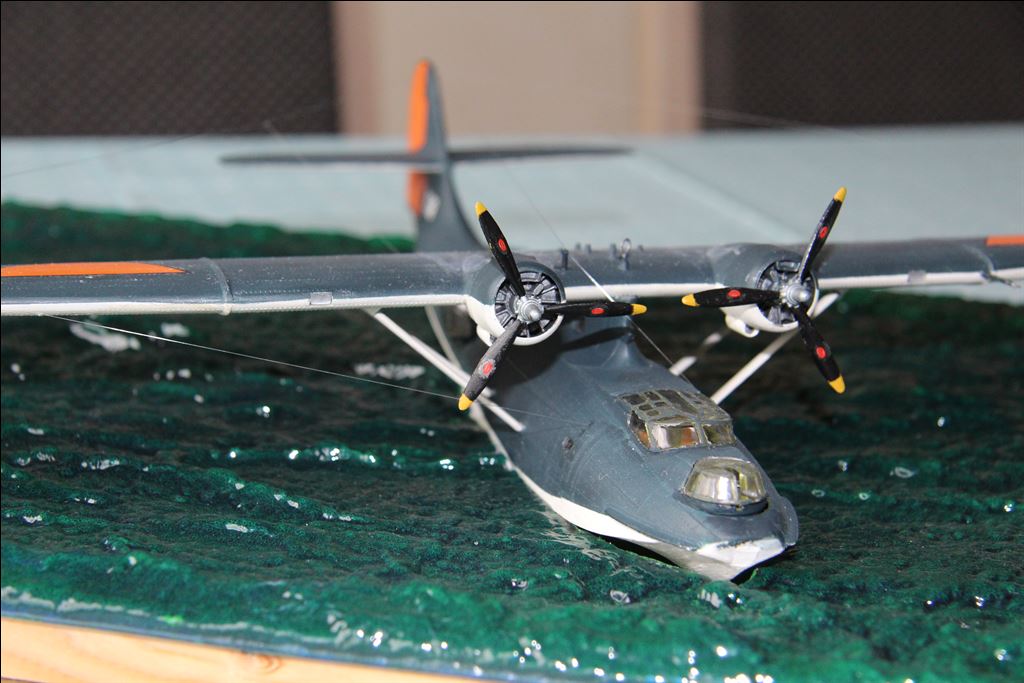
A model of a Consolidated PBY-5 Catalina, painted in the delivery scheme with orange triangles.
The kit used is the old Matchbox kit (in fact it is the Revell kit) with use of the kit decals.
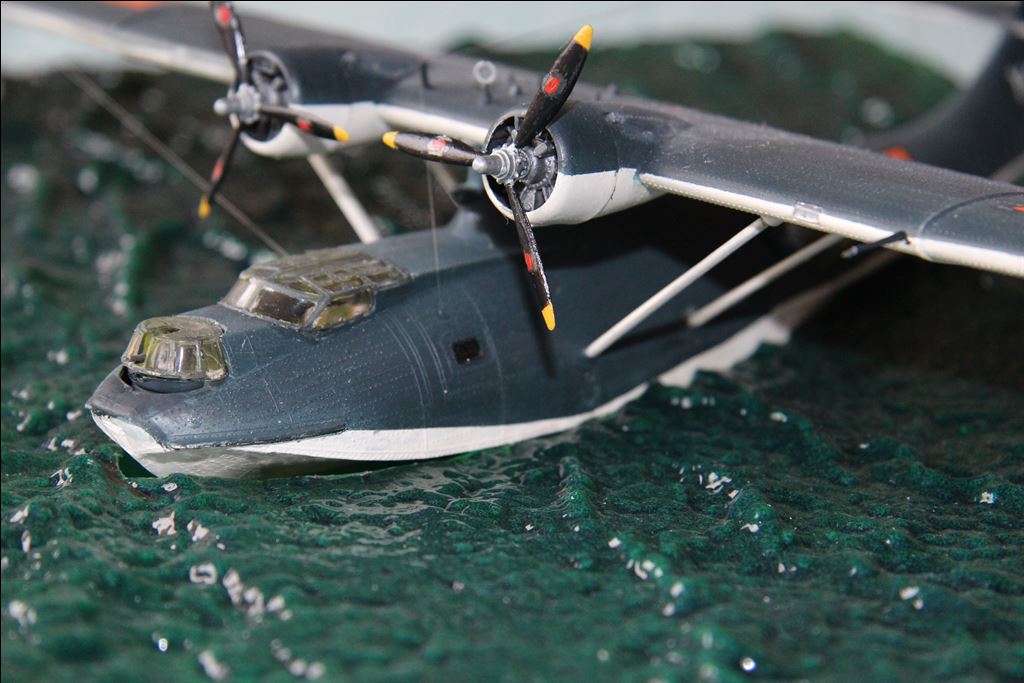
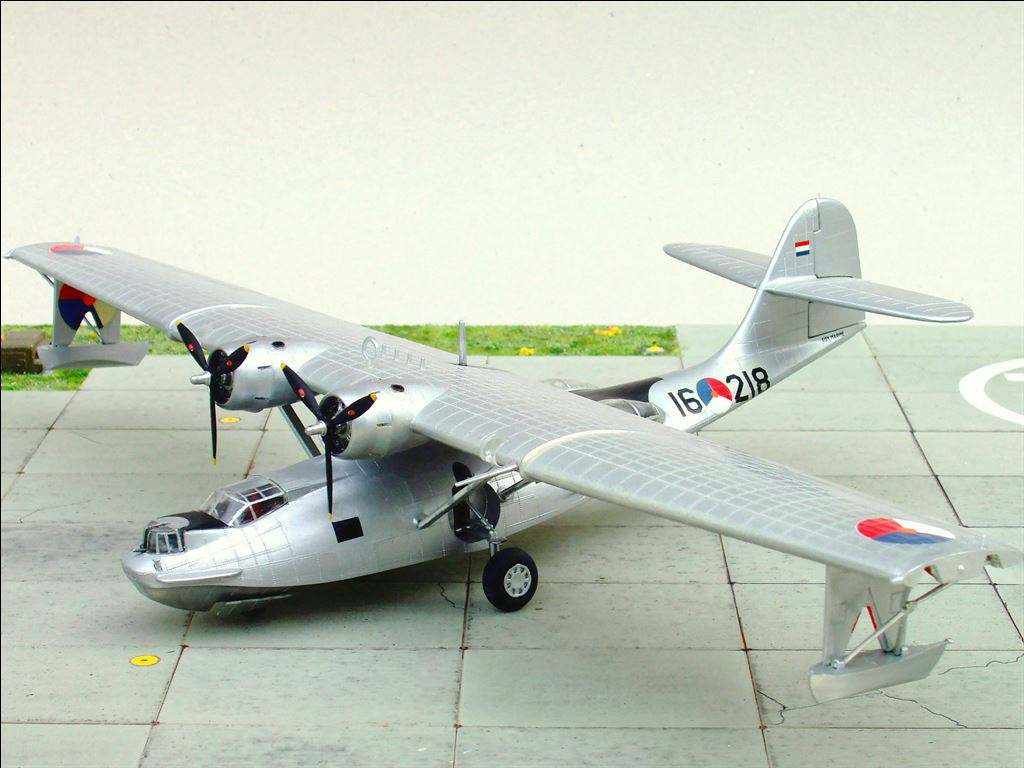
Modelling add-on
- Aeroclub
- Set E043: 14 cyl. Pratt & Whitney 1830 Twin Wasp (Catalina)
- Set P090: Hamilton Standard Hydro 12"(C47,DC3,PBY)
- BroPlan
- Set MS-67: Naval Aircraft Factory PBN-1 Nomad (PBY5) Voor Academy kit)
- Set MS-60: Consolidated PBY6A Catalina (Voor Academy kit)
- Eduard
- Set 72-242: Detailset Consolidated PBY5A Catalina (Academy)
- Set XS189: Express Mask PBY-5 Catalina (Academy)
- Falcon
- Set VAX11: US Navy WW2 Canopies voor PBY5 Catalina, F4U-1, Ventura, SB2C en F2A
- Platz
- Set M72X-04: Detailset PBY-5 Catalina (Academy)
- QuickBoost
- Set 72056: PBY1-5 Catalina motoren (Academy)
- Set 72006: PBY Catalina Props (Academy)
- Red Roo
- Set M72119:Boeing PB2B2: horizontale en verticale staartstukken voor deze door Boeing gebouwde PBY-5 Catalia (alleen resin onderdelen)
- Set M72117:Boeing PB2B2: horizontale en verticale staartstukken voor deze door Boeing gebouwde PBY-5 Catalina (als M72118 met decals)
- Set 72122: Catalina Fishtail exhaust
- RVHP Models
- Set 72130: Boeing PB2B2: horizontale en verticale staartstukken voor deze door Boeing gebouwde PBY5 Catalina
- Renaissance Flight (ex FAB flight)
- Set 72015: PBY-5 Catalina main landin gear bays (academy)
- Squadron
- Set 09162:Canopies Consolidated PBY-5 Catalina.
- Scale Aircraft Conversions
- Set 72037: PBY-5A Catalina Landing Gear (Academy).
- True Details
- Set 72037: PBY5A Catalina Wheels.
- Vector resin
- Set 72004: Pratt & Whitney R1830.
Decals
- Dutch Decal
- Set 72023: Set for several Dutch aircraft such as PBY-5 Catalina 16-205
- Set 72024: Set for several Dutch aircraft such as Boeing (Canada) PB2B-1 Catalina IVB; P-92 and Consolidated PBY-5A, Y-80.
- Set 72026: Set for several Dutch aircraft such as Consolidated PBY-5 Catalina IVA, P-206 post-war scheme; PBY-5, Y-45 with flags; PBY-5 Catalina Y-69 overall black.
- Set 72045: Set for several Dutch aircraft such as PBY-5 Catalina Y-38; Y-39 and Y-75 in early scheme with orange triangles.
- FlevoDecal
- Set FD72-023: Royal Netherlands Navy over the Dutch East Indies 1939-1942: Do24, PBY5, Ryan STM en Douglas DB7 Havoc.
- DK decals
- Set 72005: Dornier Do24 / PBY Catalina in RAAF and NEIAF Service
1/48th Scale
Kits
- Revell
- Kit 5617: PBY-5A Catalina (Revell USA)
- Kit 04507: PBY-5A Catalina
- Building repaort at Britmodeller.com
- Kit 04520: PBY-5 Catalina
- Building repaort at Britmodeller.com
- Monogram
- Kit 85-5613 / 85-5934 / 85-5617: Consolidated PBY5-A Catalina
- At IPMS Deutsland a nice building report can be found.
- Kit 85-5613 / 85-5934 / 85-5617: Consolidated PBY5-A Catalina
Modelling add-on
- Belcher Bits
- Kit XX: Consolidated PBY-5/5A Catalina Conversie set in resin.
- Kit XXX: Consolidated PBY-6A Catalina Conversie set
- Kit XXXX: Consolidated PBY-2/3/4 Catalina Conversie set
- Eduard
- Set 48-182: Detailset Consolidated PBY5 Catalina
- Set XF064: Express Mask PBY Catalina (Revell/Monogram)
- Set BIG 49116: Detailset PBY5A Catalina (Revell/Monogram) )
- Set E49-697 / FE697: Detailset PBY5A Catalina Interior Self Adhesive (Monogram/Revell)
- Set E48-827: Detailset PBY5A Catalina Exterior (Revell/Monogram)
- Set FE607: Detailset Ilyushin IL2 Self Adhesive (Tamiya)
- Set FE599: Detailset PBY-5 Catalina Interior Self Adhesive (Revell/Monogram)
- Set E48-182: Detailset Consolidated PBY5 Catalina
- Set E648-192: PBY5A Catalina Wheels (Monogram, Revell)
- Set E48-826: Detailset PBY5A Catalina Floats (Revell/Monogram)
- Set E48-825: Detailset PBY5A Catalina Undercarriage (Revell/Monogram)
- Moskit
- Set U48-01: Catalina upgrade without exhausts
- Set U48-02: Catalina upgrade with round exhausts
- Set U48-03: Catalina upgrade with fishtail exhausts
- Set U48-04: Catalina upgrade with oval exhausts
- QuickBoost
- Set 48061: Consolidated PBY-5 Catalina Engines (Revell/Monogram)
- True Detail
- Set 48095: PBY Catalina Beaching Wheel set
- Set 48101: PBY5A Catalina Wheel Set (Revell/Monogram Kits)
- Set 48457: PBY-5 Catalina Cockpit Detail set
- Set SQ41302: Consolidated PBY5(5a) Catalina Fast Frames (Monogram/Revell)
Decals
- Dutch Decal
- Set 48050: Set for several Dutch aircraft such as PBY-5 Catalina P92
- FlevoDecal
- Set FD48-016: Royal Netherlands Navy over the Dutch East Indies 1939-1942: Do24, PBY5, Ryan STM en Douglas DB7 Havoc.
| Scheme | Colour name | FS number | BS number | Humbrol | XtraColor | Vallejo Model Color | Vallejo Model Air | Hataka | |
|---|---|---|---|---|---|---|---|---|---|
| Boeing (Consolidated) PB2B-1 Catalina IVB | |||||||||
| RAF Standard #1 | Upper surfaces | Extra Dark Sea Grey | ~6099 | BS:640 | 123 / 106 | X005 / X376 | 70.866 | 71.110 | ~140 |
| Undersides | White | ~7875 | 34 | 70.951 | 71.001 | ~043 | |||
| Boeing (Consolidated) PB2B-2 Catalina VI | |||||||||
| Standard #1 | Overall | Aluminium dope | 56 / 191 | 70.864 | 71.062 | - | |||
| Consolidated PBY-5 Catalina: P-200 till P-206 (after overhaul) | |||||||||
| Standard #2 | Overall | Aluminium dope | 56 / 191 | 70.864 | 71.062 | - | |||
| Y-86 & Y-87 (later P-86 & P-87): Temperate Sea scheme, wing span larger than 75 feet | |||||||||
| Standard #1 | Upper surfaces | Dark Slate Grey | 102 | X025 | 70.892 | 71.092 | ~202 | ||
| Extra Dark Sea Grey | ~6099 | BS:640 | 123 / 106 | X005 / X376 | 70.866 | 71.110 | ~140 | ||
| Undersides | Sky | - | BS:210 | 90 | X004 / X130 | - | 71.302 | ~026 | |
| Consolidated PBY-5 Catalina: Y-38 t/m Y-73; Delivery scheme, initally orange triangles; but from february 1942 and on with flags as national insigna. |
|||||||||
| Standard #1 | Upper surfaces | Dark Sea Blue Grey: ANA 623 ?? | 35042 | 181 | X121 | 70.990 | ~001 | ||
| Undersides | Milky White | 90 (mixed with white) | X007 (mixed with white) | 70.885 | 71.103 (mixed with white) | - | |||
| Consolidated PBY-5A Catalina: Y-74 t/m Y-85, later P-75 t/m P-85 | |||||||||
| Standard #1 | Upper surfaces | Dark Sea Blue Grey: ANA 623 ?? | 35042 | 181 | X121 | 70.990 | ~001 | ||
| Undersides | Milky White | 90 (mixed with white) | X007 (mixed with white) | 70.885 | 71.103 (mixed with white) | - | |||
| Consolidated PBY-5A Catalina: P-211 t/m P-225 (after overhaul) | |||||||||
| Standard #2 | Overall | Aluminium dope | 56 / 191 | 70.864 | 70.062 | - | |||
Several colour scheme's applied on the PBY-5 Catalina.
These scheme's are meant for illustration purposes only. The size and type of used fonts of the serials, the size of the roundels etcetera might not be correct, but are as good as possible a simulation of the original.
Further there are many differences between individual aircraft regarding antennas, exhaust and also markings like squadron markings.
Many aircraft had black anti-fouling applied on the undersides of the fuselage.
Just in case you want to built a Dutch Catalina, check you references very well!
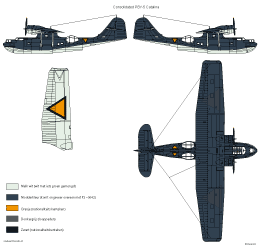
Rudder painted in camouflage colours, no Dutch markings on the upper sides of the wing.
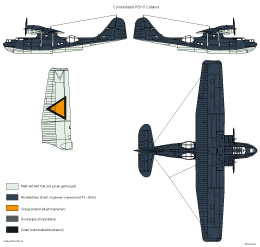
Identical to paint scheme 2. The markings on the fuselage are resized to 1/3 of the original size.
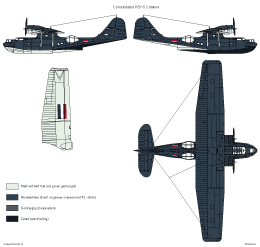
Identical to paint scheme 3, with Dutch flags as nationality markings.
Left side view : The rear part of the underside of the fuselage of Y-57 is panted with a dark (black?) colour .
Right side: Under side of the fuselage of P-200 had black anti-fouling applied.
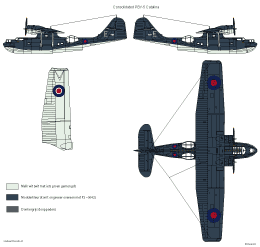
Identical to paint scheme 3, with English RAF markings. These were applied during ferry flights.
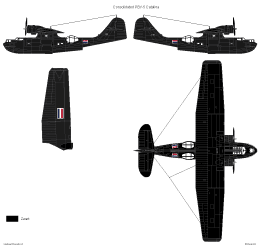
De Y-69 is one of the few Dutch "Black Cat's", these were painted overall black because of nightly operations.
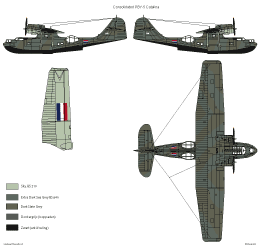
Applied on Y-86 and Y-87. Identical to the RAF paint scheme (for aircraft with a wingspan larger than 75 feet). This drawing is partly reconstructed with the help of photo's of the Y-87.
Several colour scheme's applied on the PB2B-1 Catalina IV.
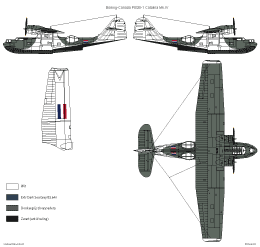
This particular aircraft still had the paint scheme of the RAF, the first owner, applied.
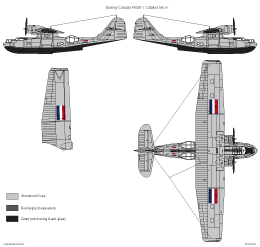
Overall aluminium-dope with Dutch flags.
Undersides of the fuselage had black anti-fouling applied.
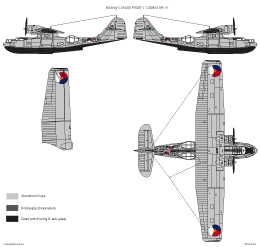
Overall aluminium-dope with Dutch roundels and new serials.
Undersides of the fuselage had black anti-fouling applied.
Colour scheme applied on the PB2B-2 Catalina VI.
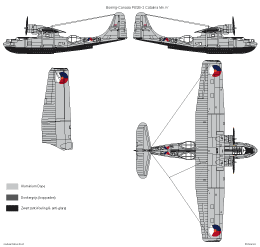
Overall aluminium-dope with Dutch flags.
Undersides of the fuselage had black anti-fouling applied.
Several colour scheme's applied on the PBY-5A Catalina.
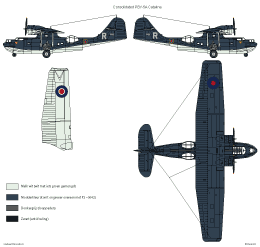
Identical to scheme 1, with English RAF markings. These were applied during ferry flights, mentioned in the test above.
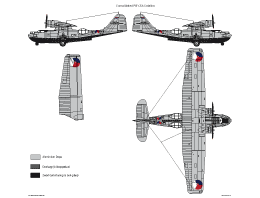
Undersides of the fuselage had black anti-fouling applied.
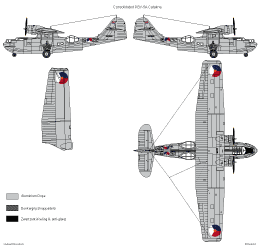
Note the changed position of several markings.
Literature.
| Zestig jaar Marineluchtvaartdienst in Beeld. | Hugo hooftman | pag. 70 | 1977 | Uitgever Europese Bibliotheek, Zaltbommel |
| AviaHobby 1ste jaargang, 11-1980, nr 11; Catalina's in Marinedienst | N.Geldhof; Hans Loeber & PaulGols. | pag. 196 - 207 | 1980 | uitgevers Wyt, Rotterdam |
| Aircraft No. 62: PBY Catalina in Action | Cpt W.E.Scarborough USN (ret) | Pag. 23 e.v. | 1983 | Uitgave Squadron Signal Publuications Carrollton, Texas, USA |
| De geschiedenis van squadron 321: Nooit op de Twode plaats | Bart M. Rijnhout | Pag. 11-26; 31- 36 | 1984 | Uitgave De Bataafsche Leeuw, Amsterdam/Dieren; |
| Modelbouw in Plastic nr 2, 1984 | Pag.26t/m 29. | 1984 | Uitgave IPMS nederland | |
| 70 jaar Marineluchtvaartdienst | N.Geldhof.. | Pag. 59 - 72; 86 - 92; 111 - 121 | 1987 | Uitgave: Eisma BV , Leeuwarden |
| 40 jaar Luchtvaart in Indië | G.Casius en T.Postma. | Pag. 55; 75; 91; 109 - 110; 125 - 126; 130; 147. | Uitgeverij De Alk, Alkmaar | |
| Luchtvaartwereld; 3e jaargang nr. 1, 1 - 1986: Naoorlogse Catalina's van de MLD | N.Geldhof | pag.25 - 28 | 1988 | Uitgave Ten Brink, Meppel |
| Air Enthusiast 38 : In praise of the Consolidated PBY - The maginificat | William Green, William & Gordon Swanborough | pag. 1 - 18 | 1989 | Uitgever Pilot Press Ltd., Bromley, Kent |
| Nederlandse Militaire Luchtvaart III: Consolidated PBY-5/A Catalina | N. Geldhof | 1989 | Uitgave Stichting Vrienden v. h. Militaire Luchtvaart Museum (i.s.m. de afd. Luchtvaartkennis KNVvL. | |
| Vliegtuigsquadrons 320 en 321 50 jaar | P.Bartels & P Staal. | 1990 | Uitgave van Jubileumcommissie 320321 | |
| Camouflage en Kentekens | J.Greuter e.a. | 1997 | Bonneville – Bergen (NH) | |
| The Consolidated PBY : Bewaker van de Pacific | P. P. Staal & Nico Geldhof | 2004 | uitgeverij All media Productions, hilversum |
Websites.
ul
Note
This article was published in 1993 in the magazine "Modelbouw in Plastic" (Scale Modelling in Plastic), a release of the IPMS Netherlands
Special thanks to M. Schönfeld , P. Staal and R. Burgerhout for their informatian and line-drawings of the Catalina.
| 990 |
